Here are 4 excellent reasons to visit Ecuador.
Food
Before I moved out here, I often got asked ‘what do Ecuadorians eat?’ A quick google search is straight up nightmare fuel.
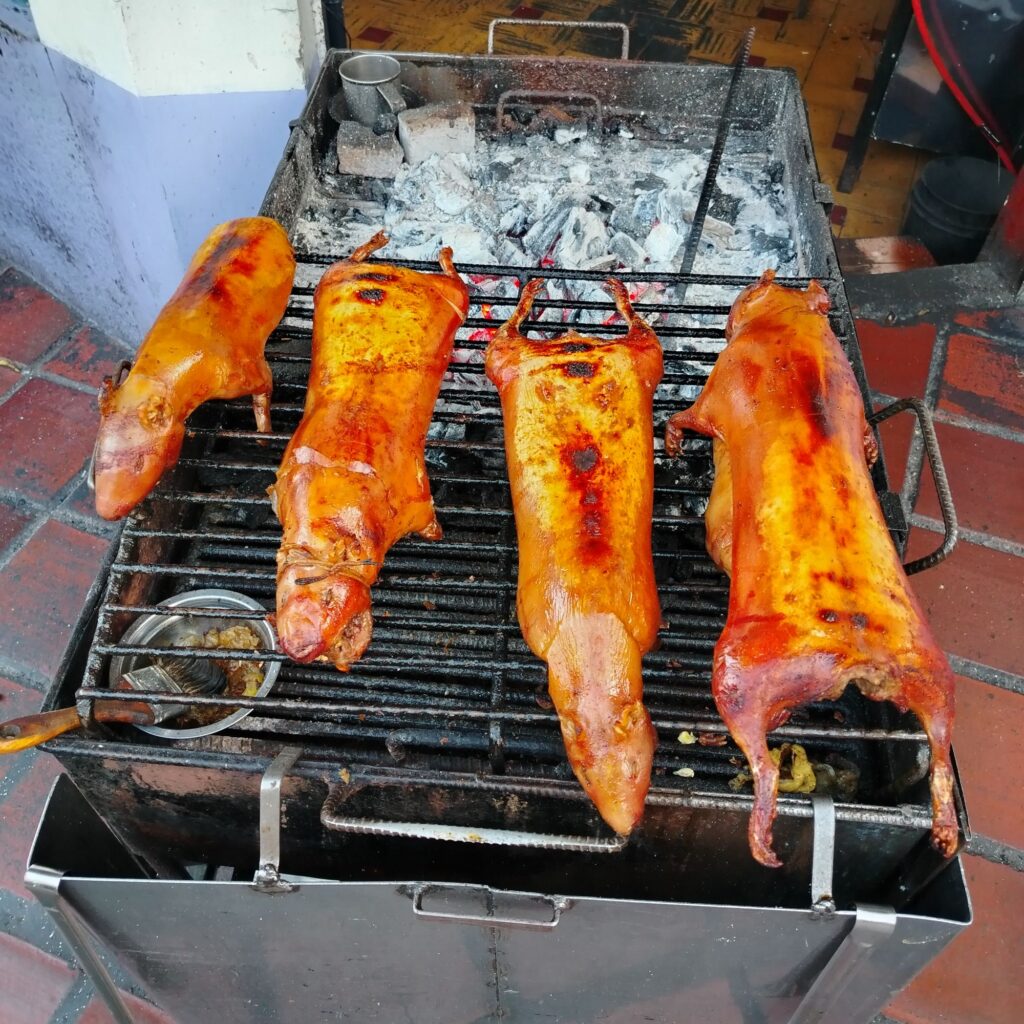
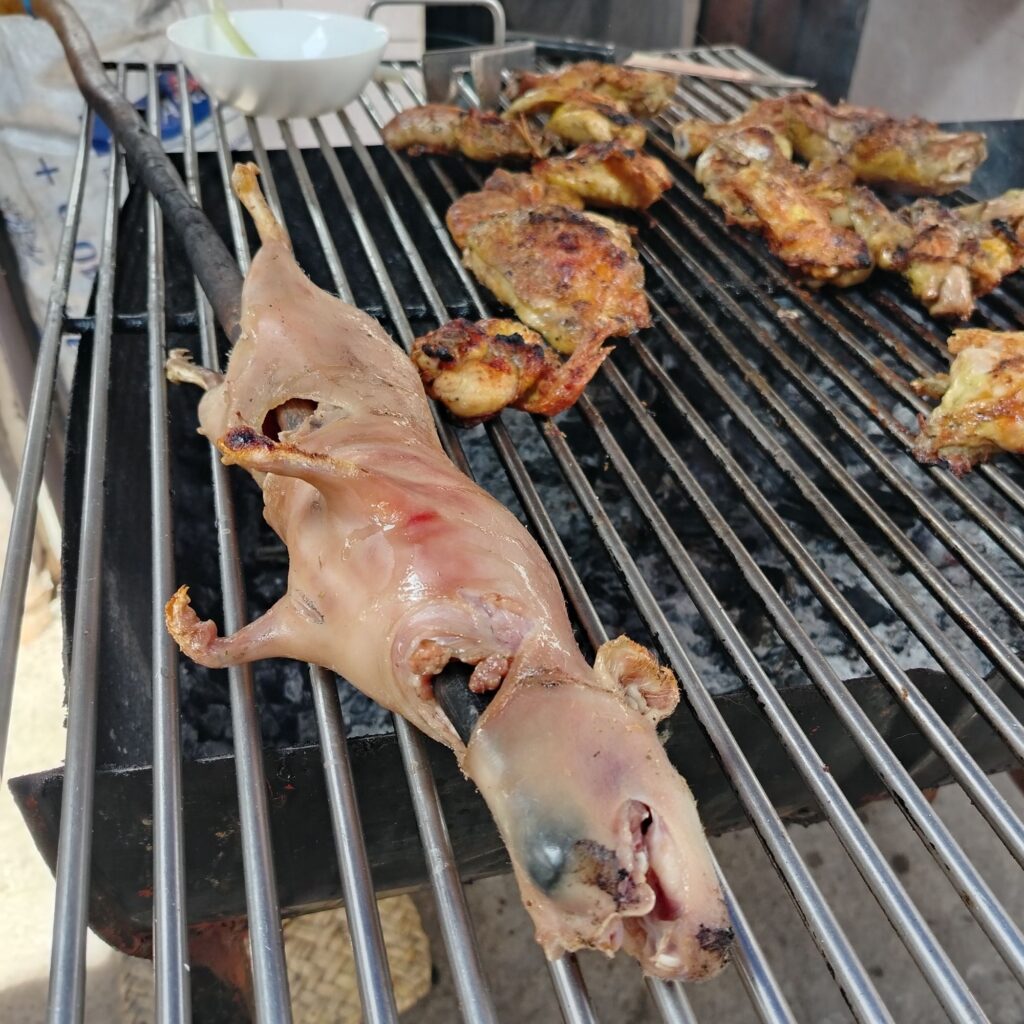
Dead rat on a stick.
I was prepared for the worst.
But I needn’t have worried. It turns out that the cuisine is actually one of the real unsung triumphs of this little country.
Like many things in Ecuador, you can roughly divide the food into the major regions: Costa (coast), Sierras (mountains), and Oriente (amazon). Galapagos would be the forth, although I haven’t been out there yet!
First of all, there is a fantastic restaurant culture based around almuerzo (lunch). Most traditional restaurants offer a very affordable standard almuerzo menu, typically consisting of a soup, a main dish and a drink. I’ve never seen this cost more than $3.50. The cultural impact of this is significant; workers aren’t forced to snatch a quick sandwich at their workplace, but can actually take the time to sit down and talk to one another. In the UK we have an awful work culture regarding lunch. The hospitality industry loudly bemoans people not eating out, yet a basic burger and drink can easily set you back a good £15 (about $19). Good job Ecuador!
Platos fuertes (main dishes) of the Sierras pretty generally consist of some kind of meat, rice, potatoes, salad, and sometimes a menestra of beans or lentils. I guess in the west we generally only have one type of carbohydrate on the plate, so it took a little while to get used to having rice AND chips, AND sometimes maize.
There is a big indigenous influence on the cuisine here, with lots of very healthy dishes based on a range of pre-hispanic grains and pulses. Choclo (maize) used to be the staple carbohydrate in this part of the world.
Yuca, or cassava is another pre-hispanic carbohydrate that you can find around the country. It seems to be mostly cultivated in the more tropical regions, such as the oriente. Pan de yuca (yuca bread) is absolutely delicious!
Trout and tilapia are the cheapest and most readily available fish in the sierras and oriente, with many commercially stocked lakes and rivers throughout the country, and they certainly know how to take care of them in the kitchen.
Rotisserie chicken is usually available, in even the smallest towns. It’s usually served with an excellent chicken soup called consome de pollo, as well as the ubiquitous rice, salad and chips.
People eat quite a bit of offal here. There are some fantastic dishes, such as guatita, which make use of the parts of the animal that we often throw away in the west. Morcillo (blood sausage) is one of my favourites. It bears a very strong resemblance to the British ‘black pudding’. It’s not unusual to find chicken feet floating around in your consome, but don’t knock it till you’ve tried it!
The variety and quality of fruit in this country is like nothing I have ever had before in my life. It is all very affordable too.
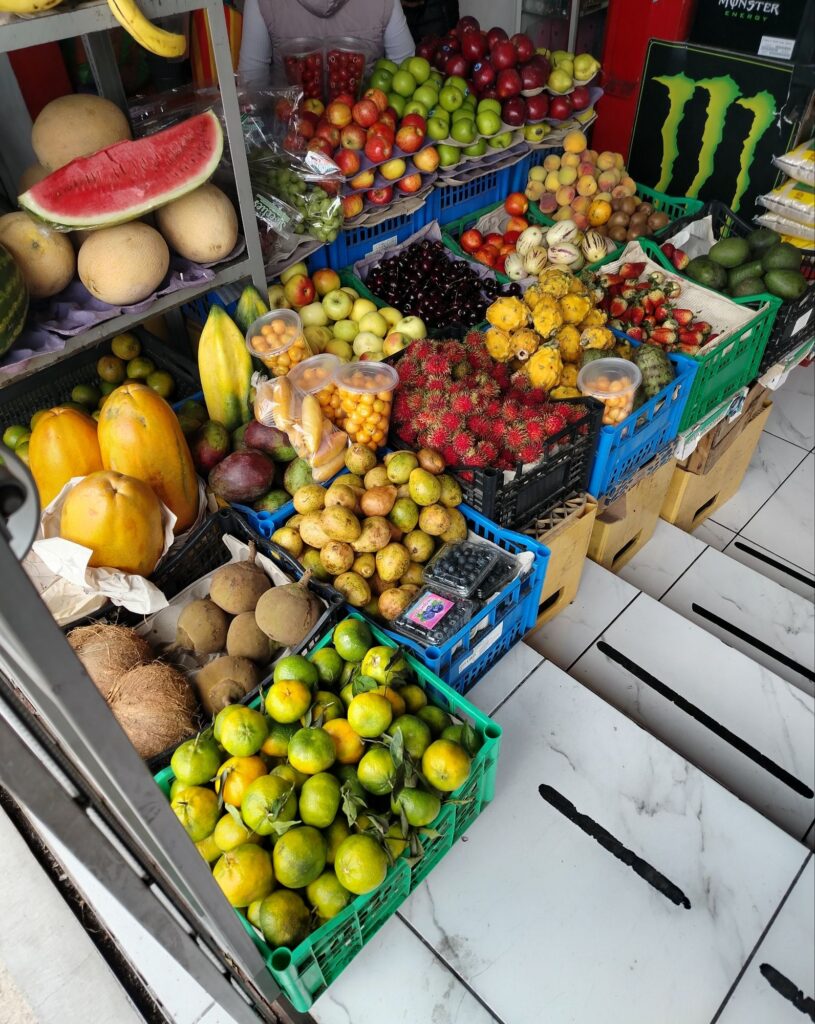
This is just a little tienda near my apartment, but it still has about 5 different types of fruit that I had never seen before coming to this country.
Yes, we do need to talk about the elephant, or rather, the guinea pig in the room. Cuy was a significant source of animal protein in the andean region in pre-hispanic times. These days the indigenous generally prefer to eat chicken, beef or pork. Perhaps it is more efficient to farm these animals? Or is it that people have gained a western taste over the years? You can still find cuy around, and it is considered a delicacy.
I finally decided to take the plunge…
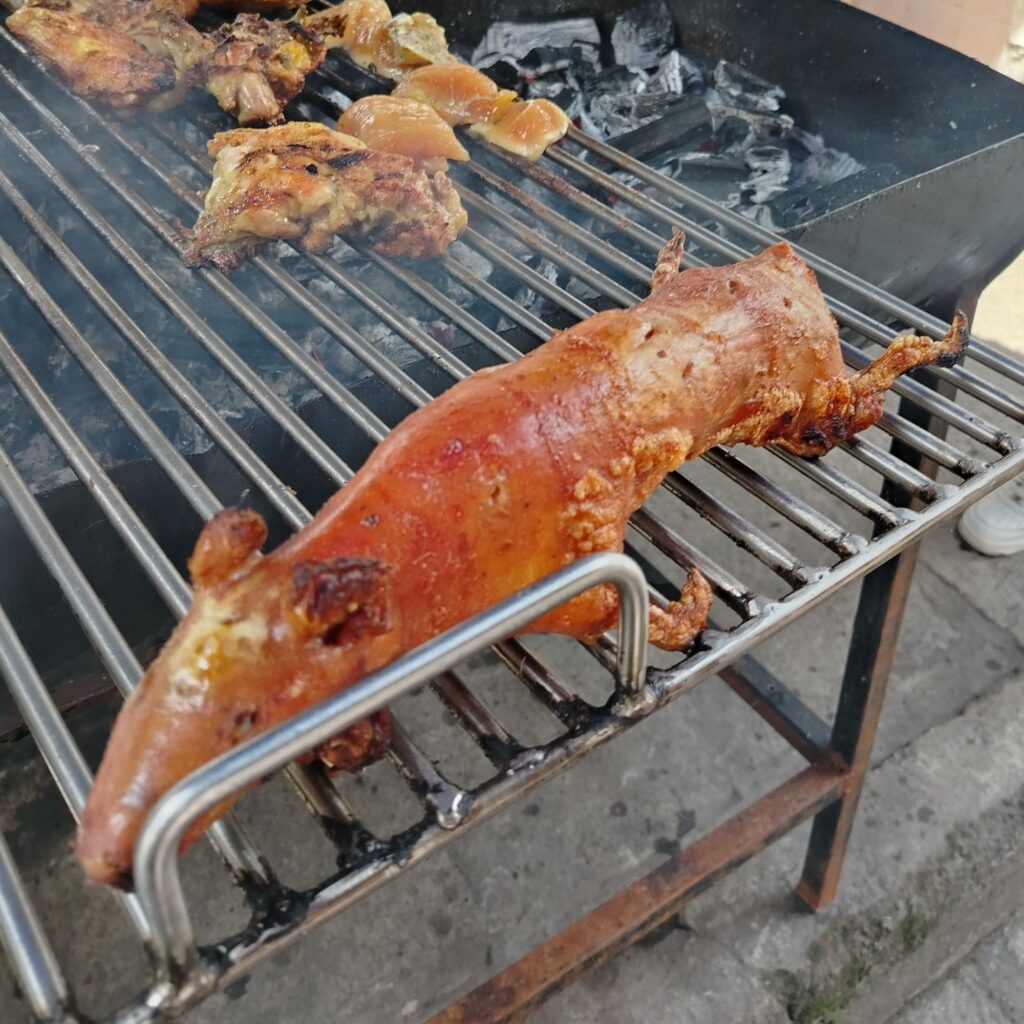
Actually not half as bad as it appears, although it’s probably not advisable to look the thing in the eye while eating it.
It has a flavour similar to chicken leg meat. My only complaint was that it left quite a strong fishy smell afterwards. I would be up for giving it another try.
Have you ever wanted to eat raw, alive and wriggling larvae? That’s an experience that you can have in the amazon. Chontacuro, or palm weevil larvae, was once a very important protein source to the indigenous populations here. I can attest that, having been cooked, it tastes like king prawn. It was good enough that I would try it again. People often just eat the thing live. Apparently it bursts into a creamy liquid.
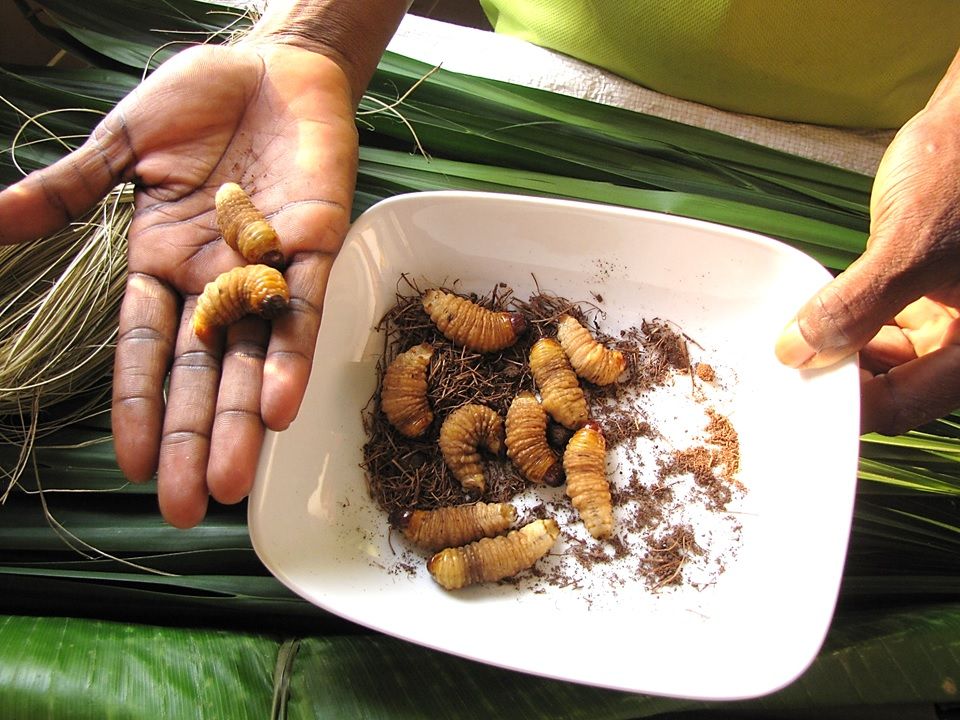
Source: Wikimedia commons.
I’ve left the best until last…
The food that you find in the coastal region of Ecuador is on a completely different level. Ecuador is the number 1 exporter of shellfish on the planet, the freshness and variety of seafood that is available here is simply incredible.
Most seafood is available in a few basic variations: encocado (cooked in a coconut sauce), al ajillo (in a garlic and cream sauce), apanado (battered) and fritado (fried). Then you’ve got things like conchas asadas (a type of bivalve shellfish), encebollado and ceviche, which have their own thing going on. Most Ecuadorians consider those last two to be the finest dishes in the nation.
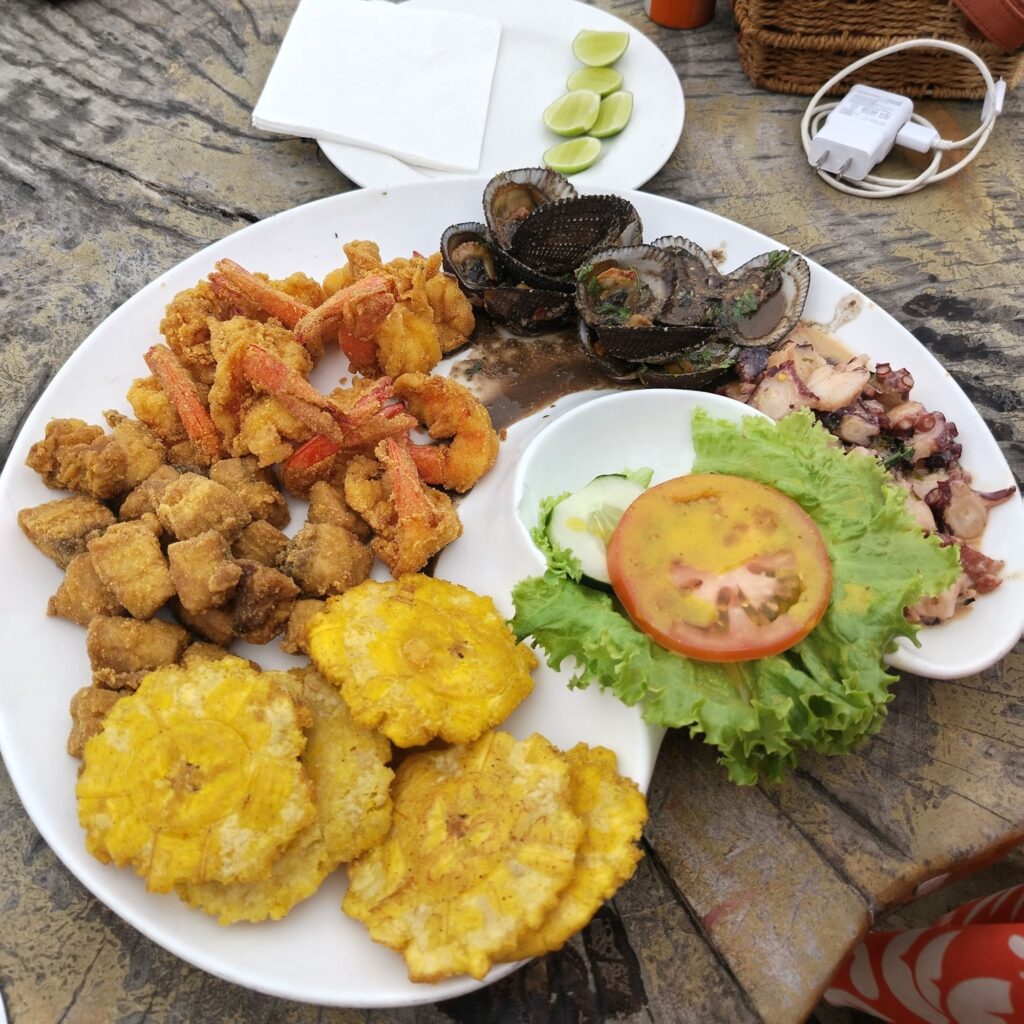
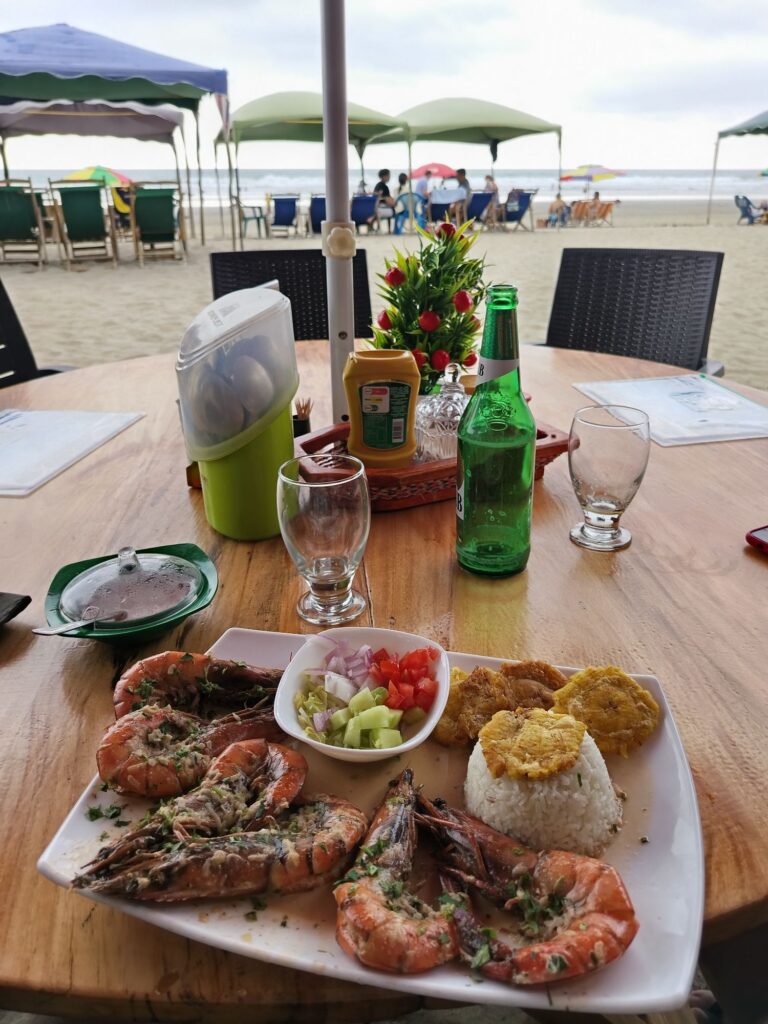
Langostinos al ajillo.
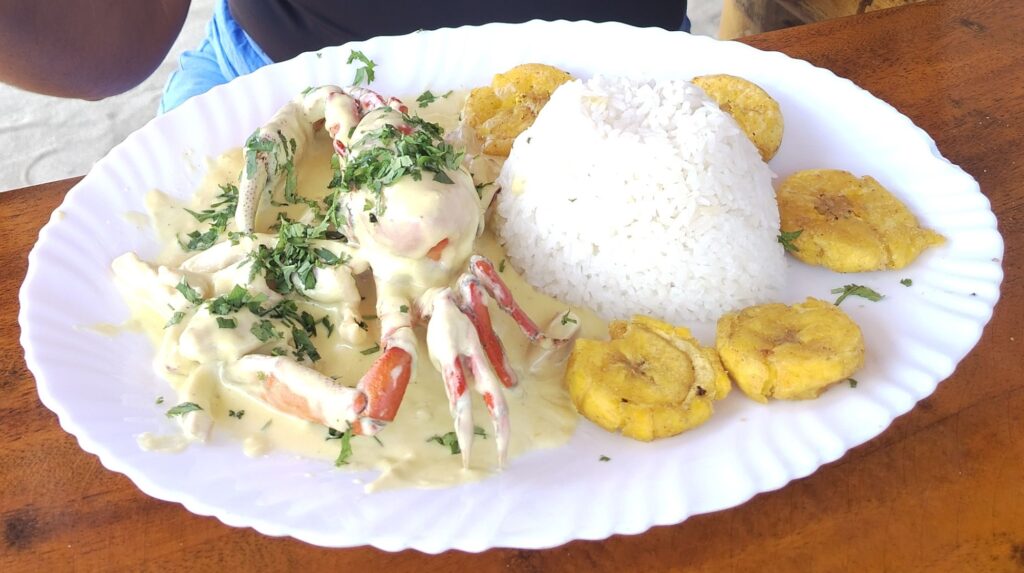
Cangrejo encocado.
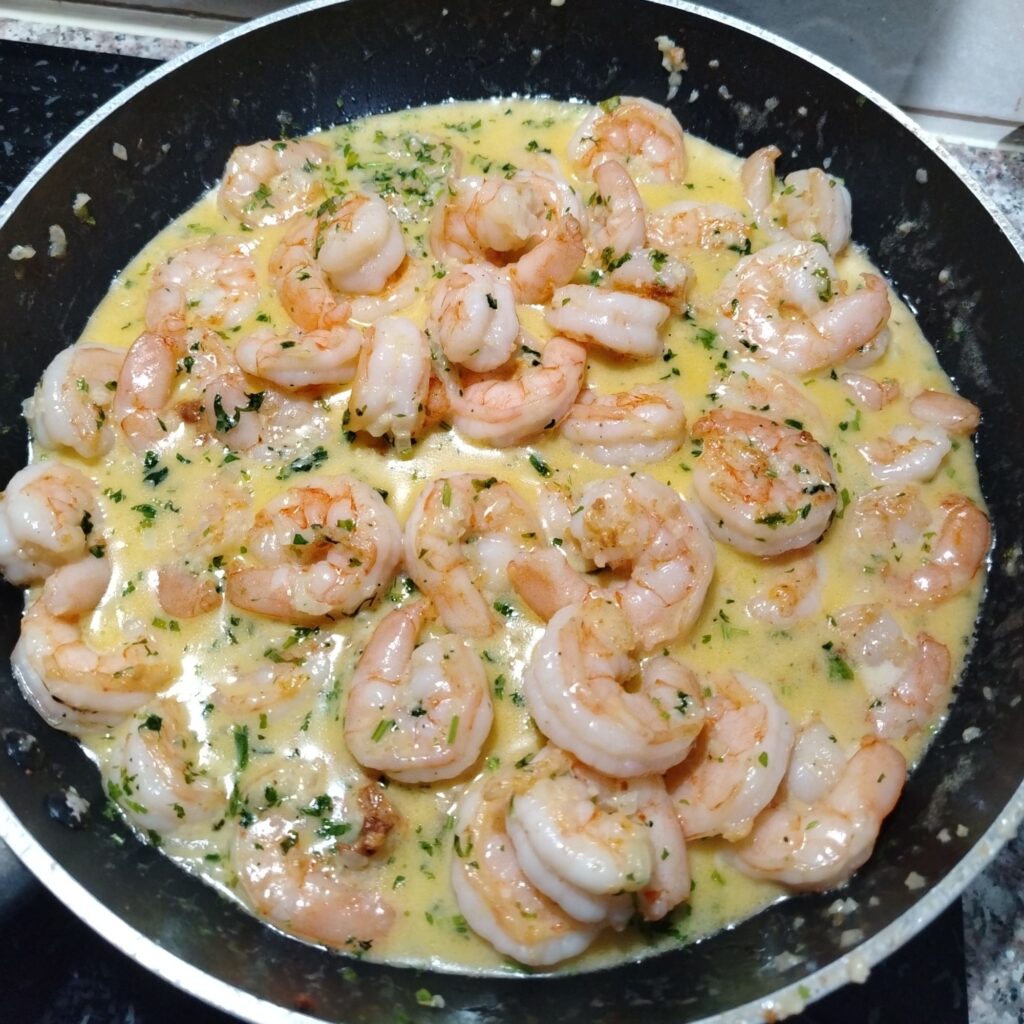
Our homemade attempt at camarones al ajillo.
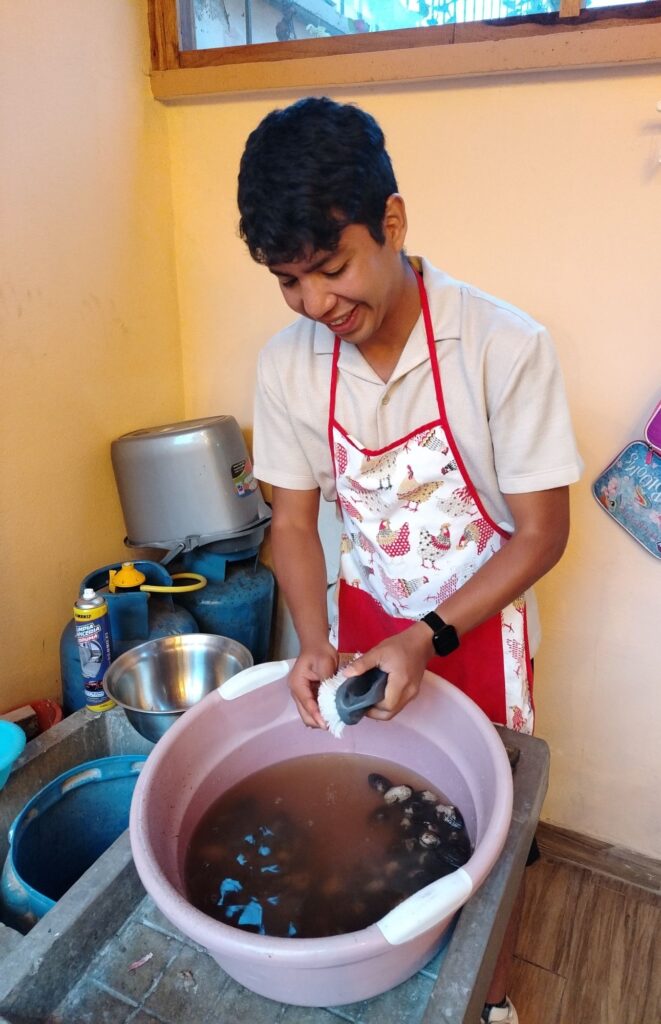
Above: Adrian scrubbing up the conchas. Below: conchas asadas cooked on the BBQ.
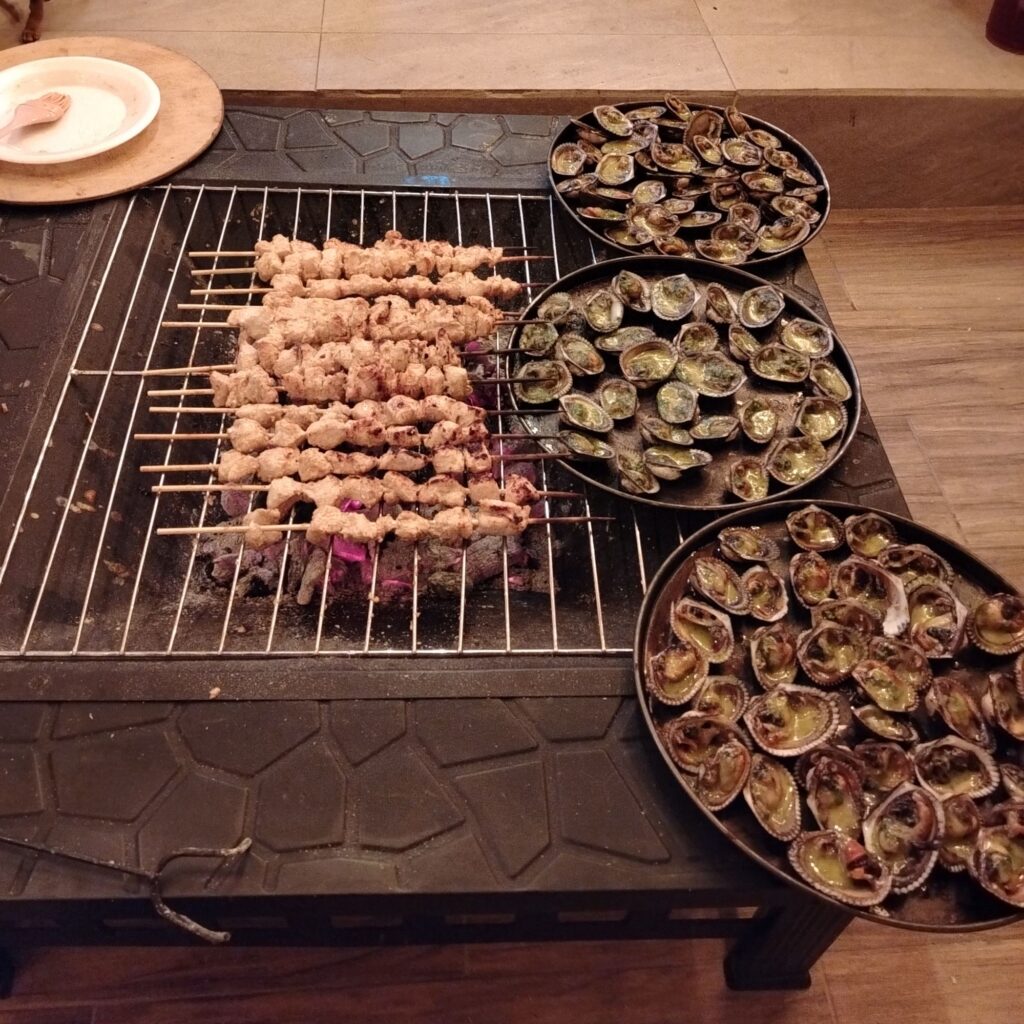
The coastal breakfast is now one of my favourites in the world. They make extensive use of the green plantain (verde) throughout the day, although it really comes into its own at the breakfast table. Trigillo, bolon and patacones are the three main dishes. Bolon and trigillo are usually mixed with cheese, chicharrón (crispy pork belly), or both. Patacones are usually served as a side dish, a bit like french fries. Golden crispy goodness.
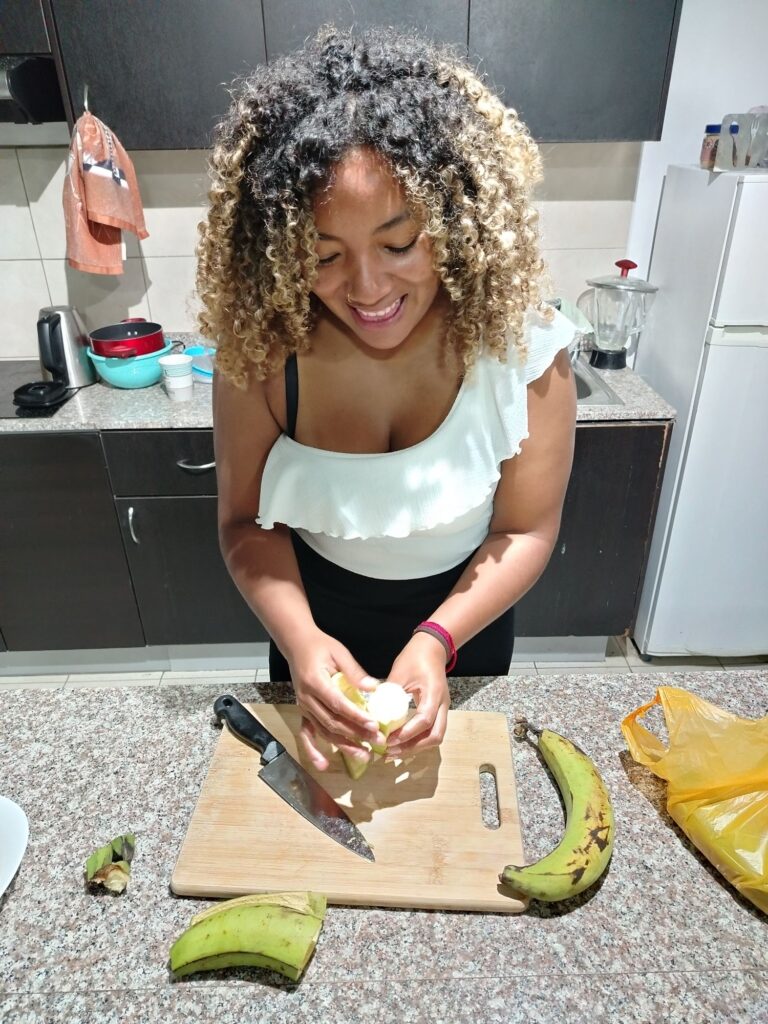
Raquel chopping and peeling green plantain (verde). It’s more or less a banana. If you leave it to mature it turns yellow and becomes sweet tasting (maduro).
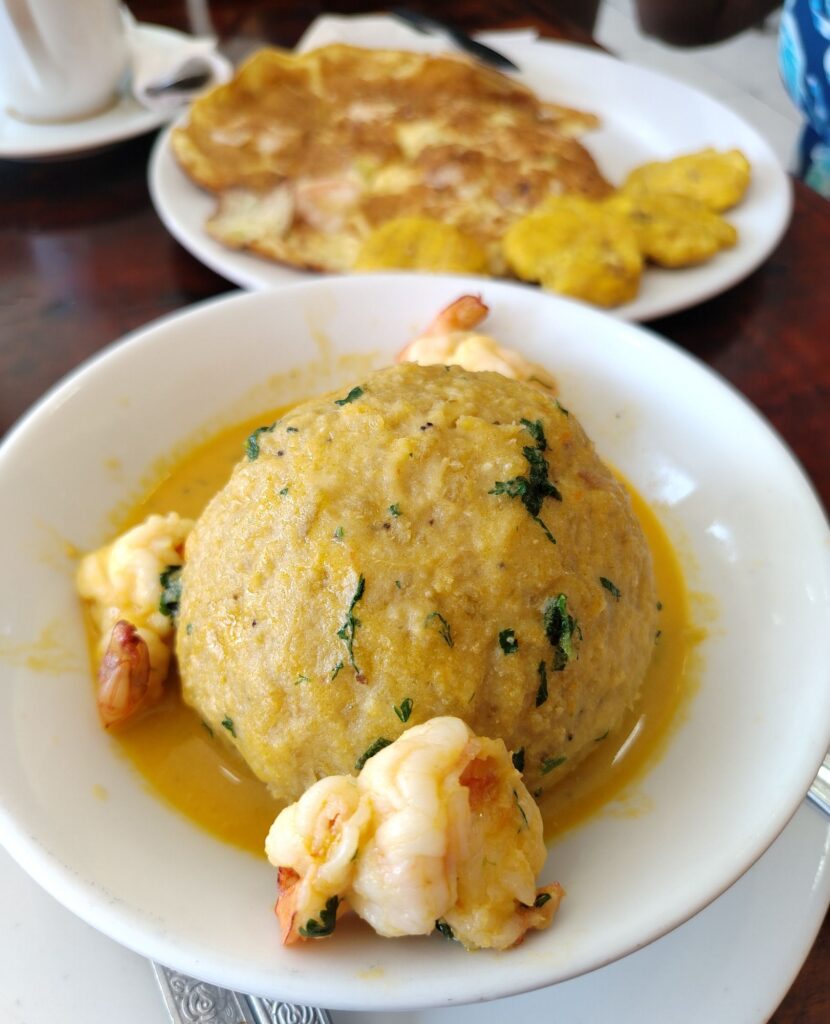
Foreground: Bolon al ajilo con camerón. Background: Tortilla de cameron con patacones.
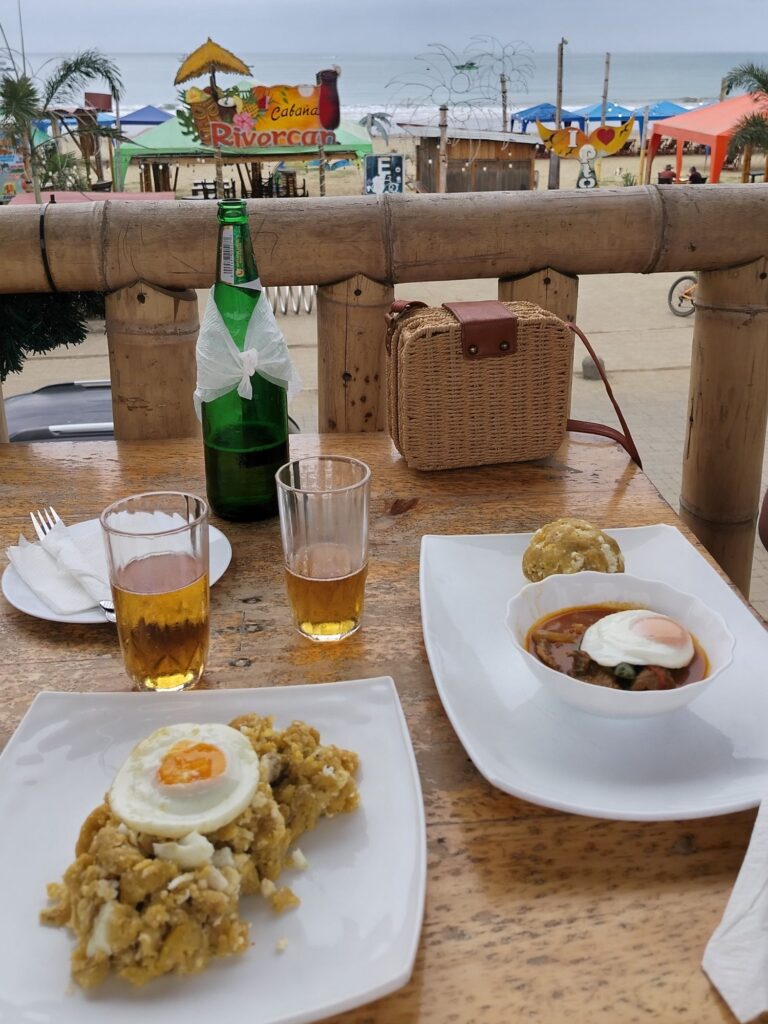
Left: Trigillo mixto (crispy pork belly and cheese). Right: Bolon con bistek.
As an honorable mention, Salchipapas. This is the cheeky kebab of Ecuadorian cuisine; it’s available all over the country as a quick, cheap, greasy and delicious fast food. When Friday comes around and I don’t want to cook, this is my salvation.
This country is a natural wonder and an adventure playground
The Amazon Rainforest, the Galapagos Islands, the Andes, and a tropical coastline. Ecuador has 91 distinct ecosystems, supporting 10% of all the world’s plant species and 8% of animals. The abundance of natural wonders that exist in this country is something that you could never get tired of in a thousand lifetimes.
In just a year and a half of living here I have travelled the length and breadth of the mainland. This might sound like a major undertaking, but the country is so small that you can easily traverse it by road within a single day. Fall asleep on a bus leaving Quito on a Friday night and wake up to take breakfast amongst the mangroves on Saturday morning.
Compared to a lot of Latin America, Ecuador has a relatively heavily populated countryside. In fact, many of the mountainsides had been terraced and farmed long before the Spanish even arrived. Rural main roads are generally paved, and kept in good condition, providing good access to the provinces.
Ecuador is divided down the middle by the Cordillera de Los Andes (the Andes Mountain Range). Ecuador’s 84 volcanoes provide a dramatic backdrop to life up in the hills, with Volcán Chimborazo (6263m) being the highest. Ecuadorians don’t miss a chance to remind you that technically Chimborazo is the highest peak on the planet, since the volcano is more or less sitting on the Equator, and since planet Earth is a squashed, mandarine-like shape, rather than a sphere, Chimborazo is the furthest point from the centre of the planet.
If the skies are clear in Quito, you can see 3 of the 4 highest peaks in the country.
It never fails to lift my spirits on my commute to work when I see Cotopaxi squatting over the city.
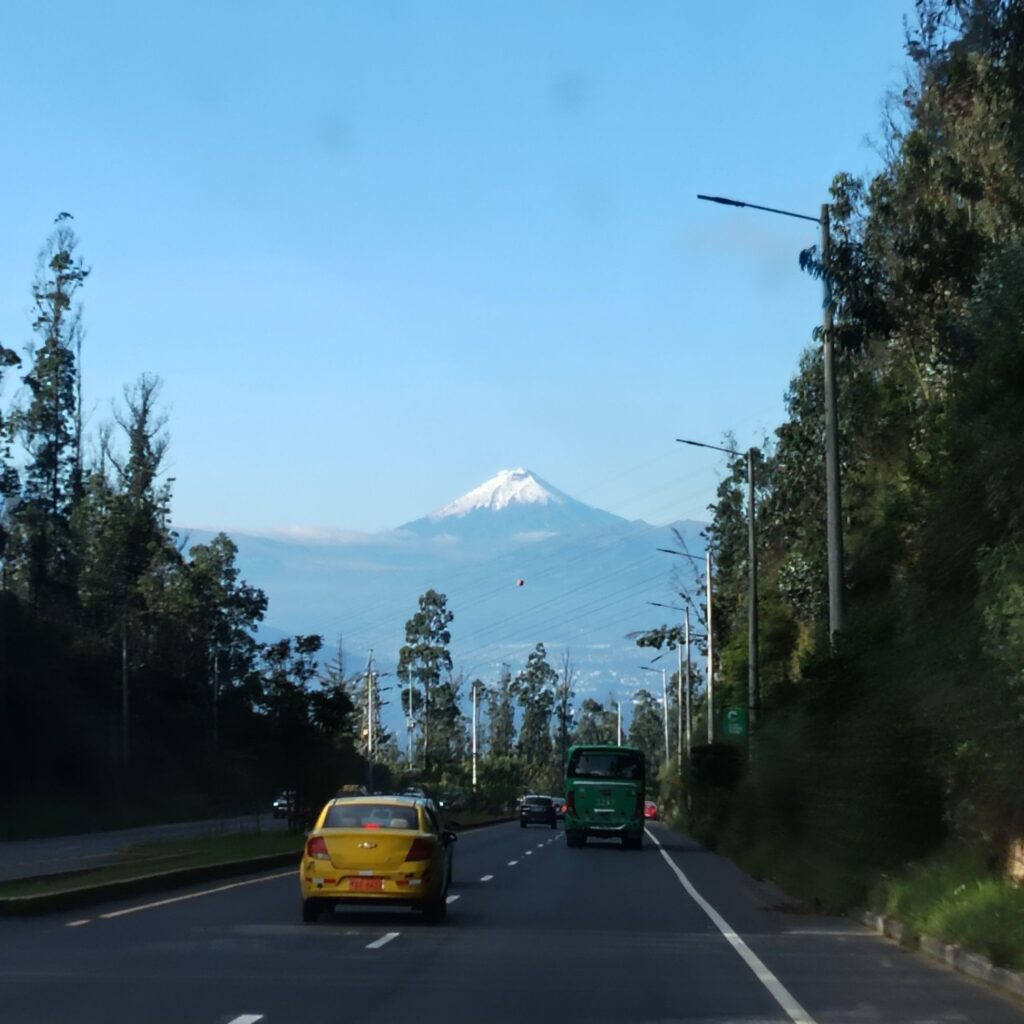
Climbing these frozen peaks is proper mountaineering. You need a guide, all the kit, and have completed several acclimatisation hikes beforehand. Mountaineering has earned an unfortunate reputation for being ludicrously expensive to the point of being out of reach for the common man, but over here you can climb Cotopaxi for just a shade over $300, with guide, transport, and gear rental included.
But if that seems just a bit too extreme, there are innumerable opportunities for hiking and biking up and down the length of the cordillera. You sometimes can spot Condors around the bigger slopes.
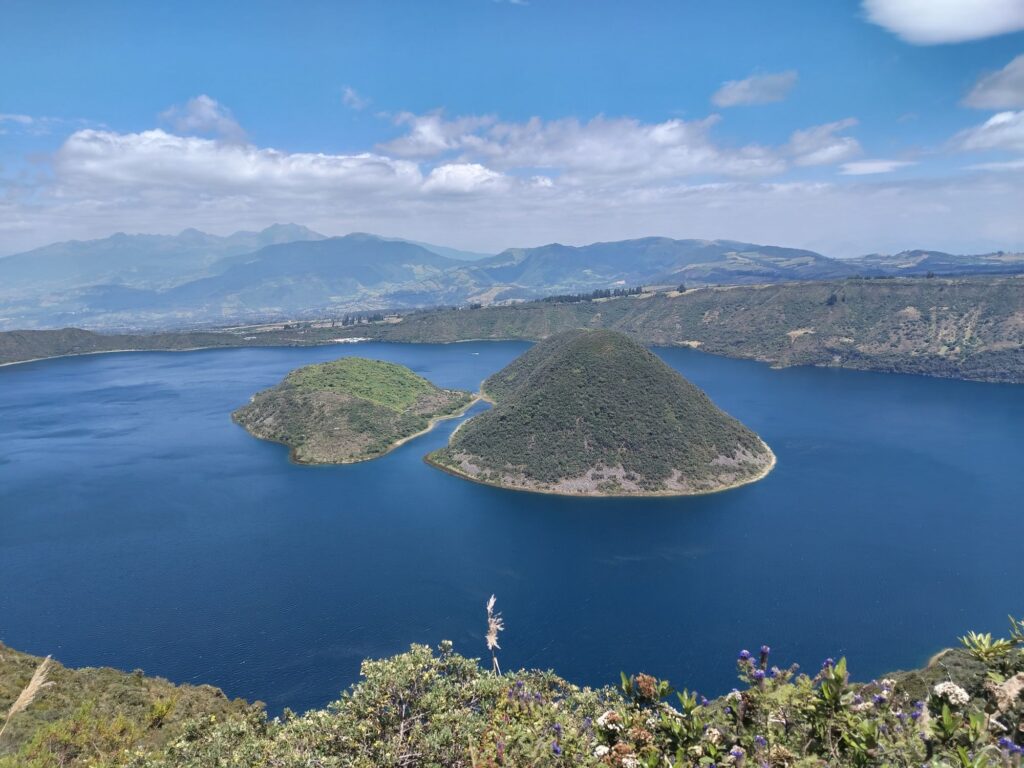
Laguna Cuicocha, near Otavalo.
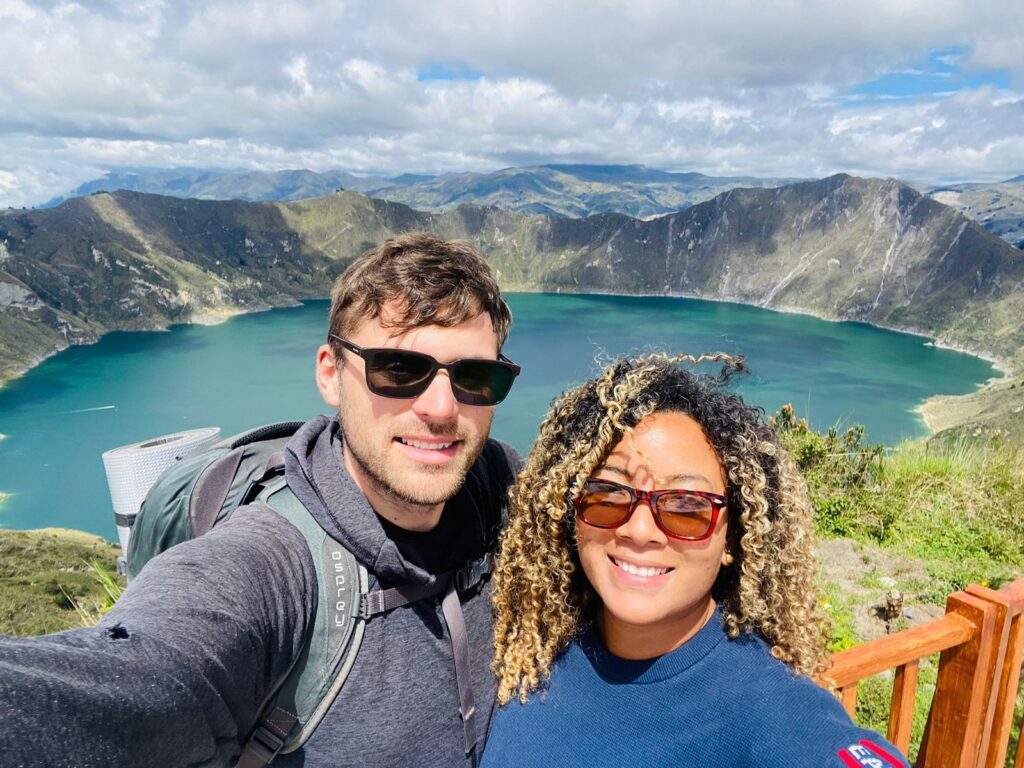
Laguna Quilotoa with Raquel.
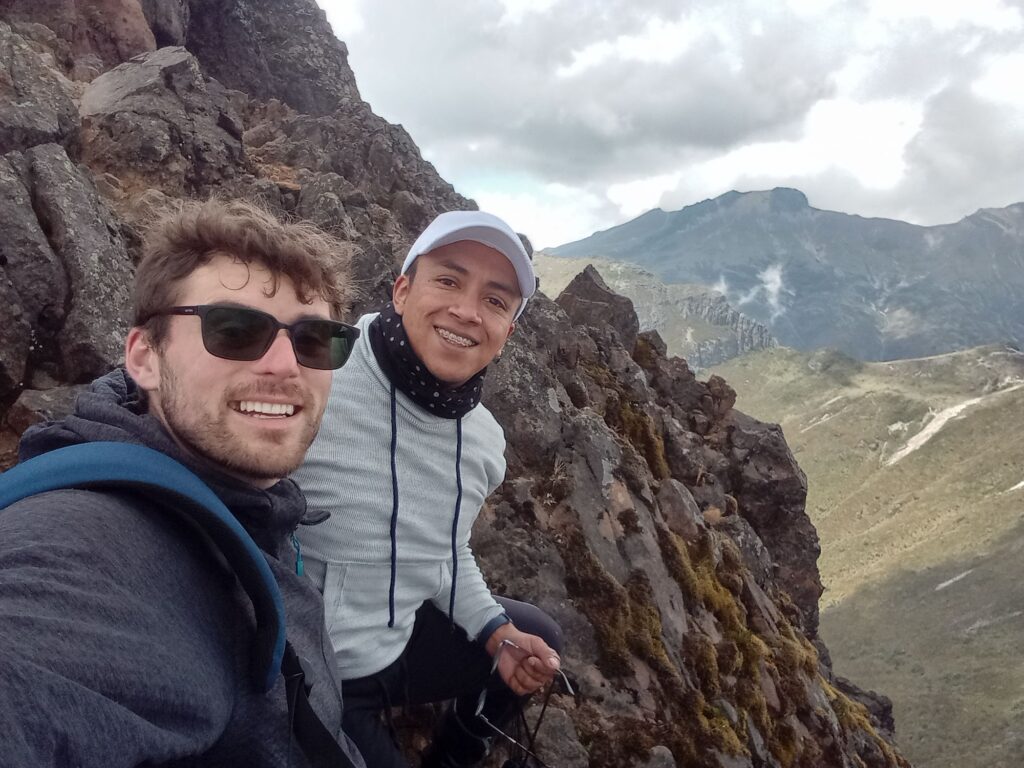
Climbing Rucu Pichincha with Marcello.
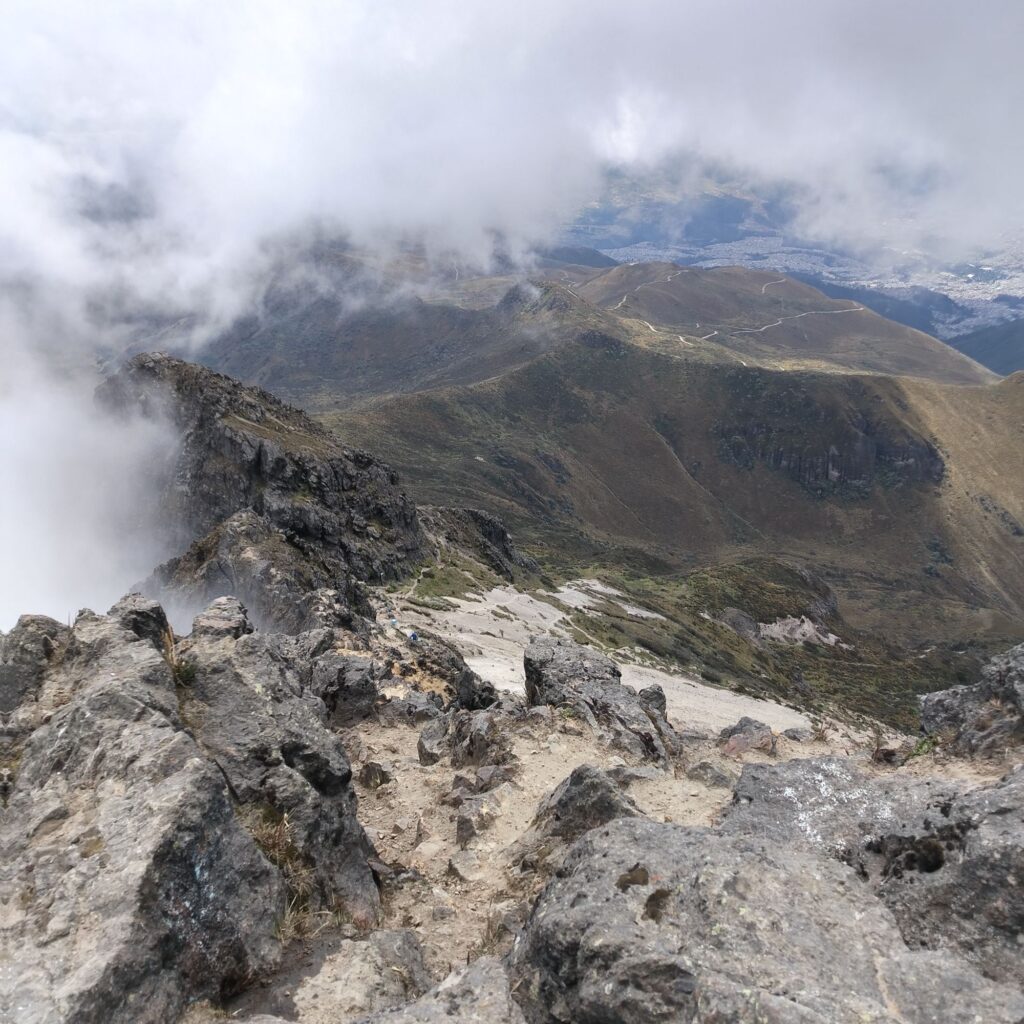
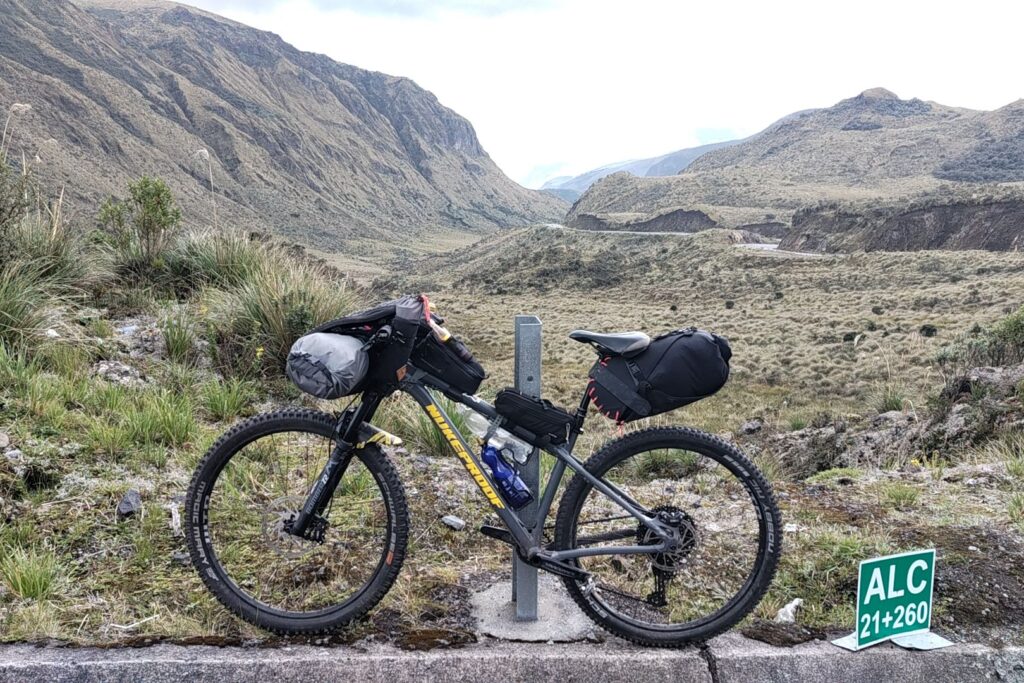
Playing in the mountains east of Quito.
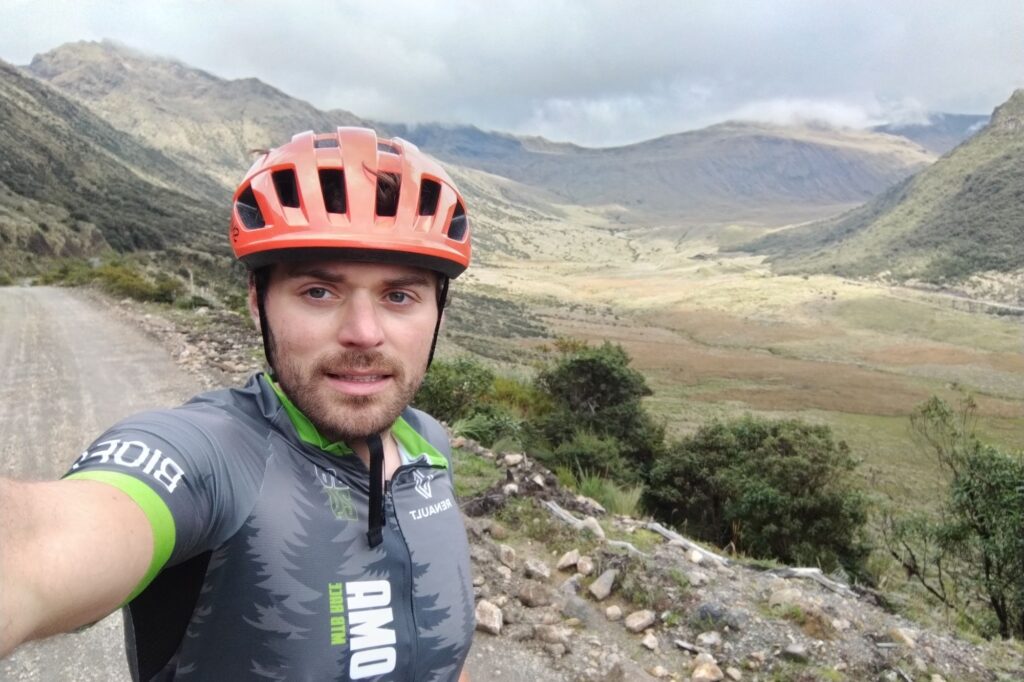
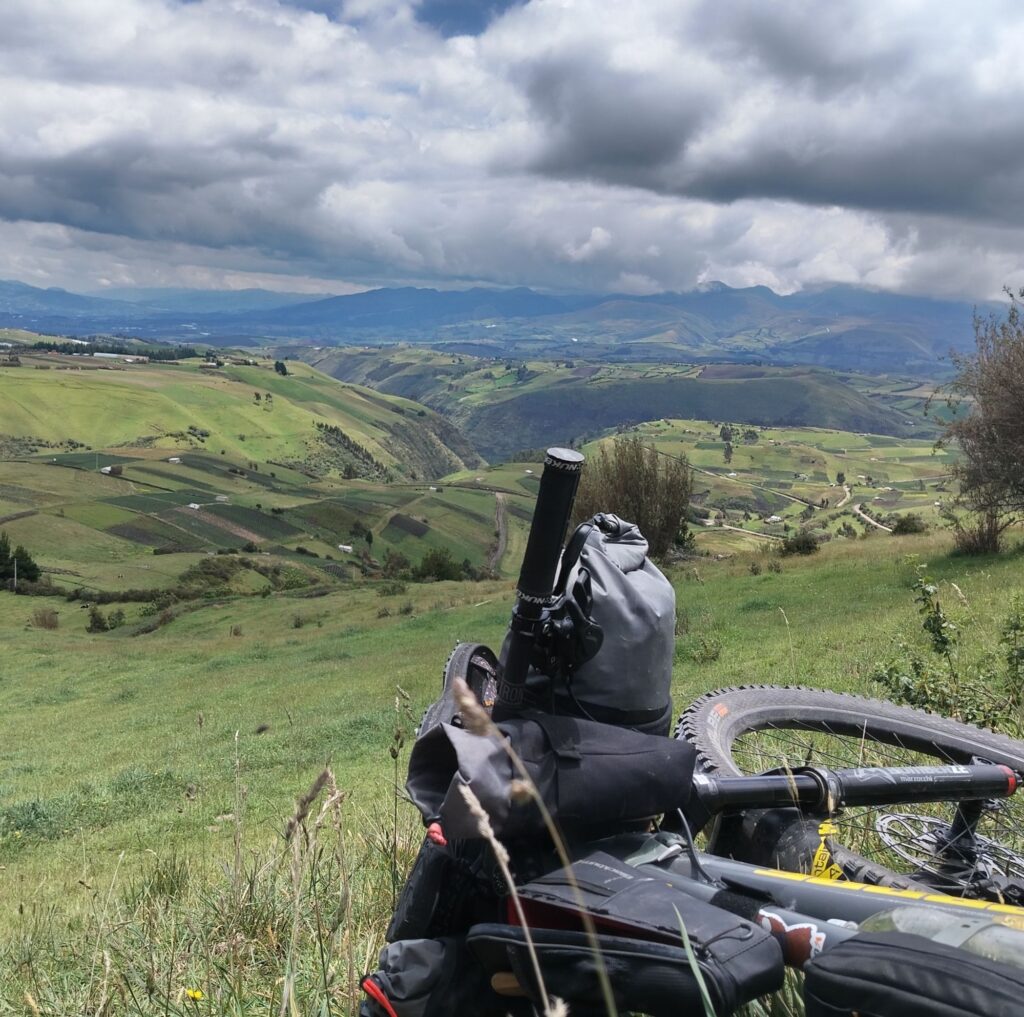
Looking towards Cayambe.
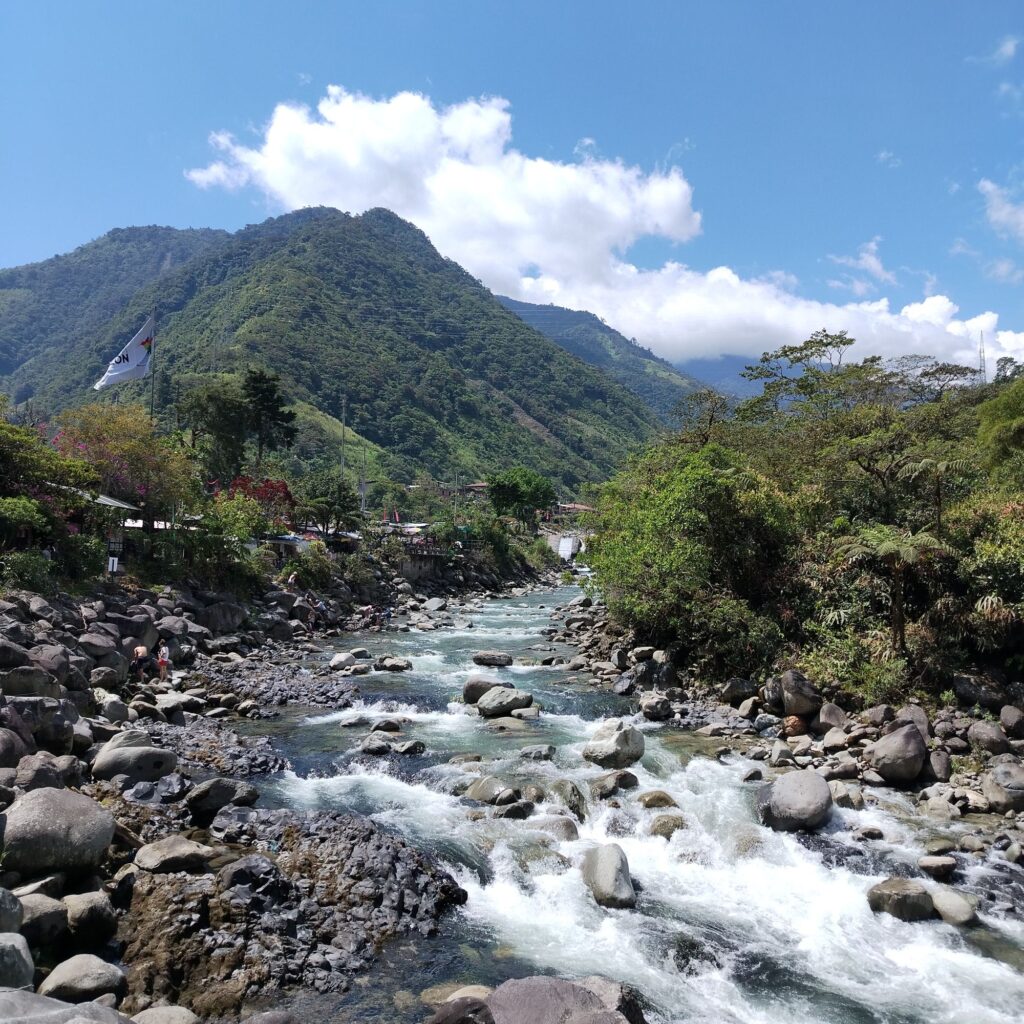
Baños.
My favourite ecosystem of the sierras has got to be the cloud forest. Warm, humid air rises from the coast and is pushed up the slopes of the Andes. Eventually, with altitude, the temperature is reduced to its condensation point, creating clouds. These humid conditions provide for a lush, green, hilly scenery. Compared to the Amazon there are very few poisonous nasties that can ruin your day, which makes for a far more carefree place to camp and mess around outdoors.
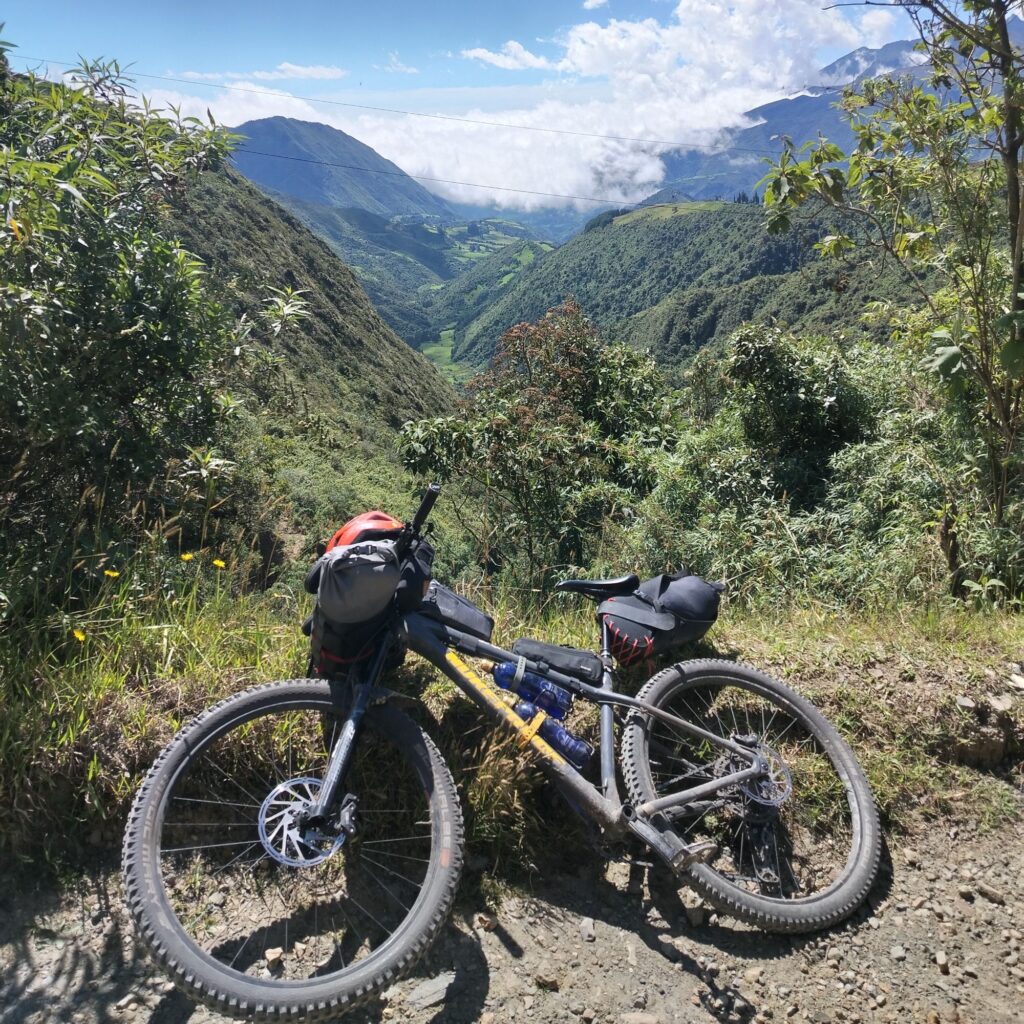
Riding through the cloud forest to the east of Quito.
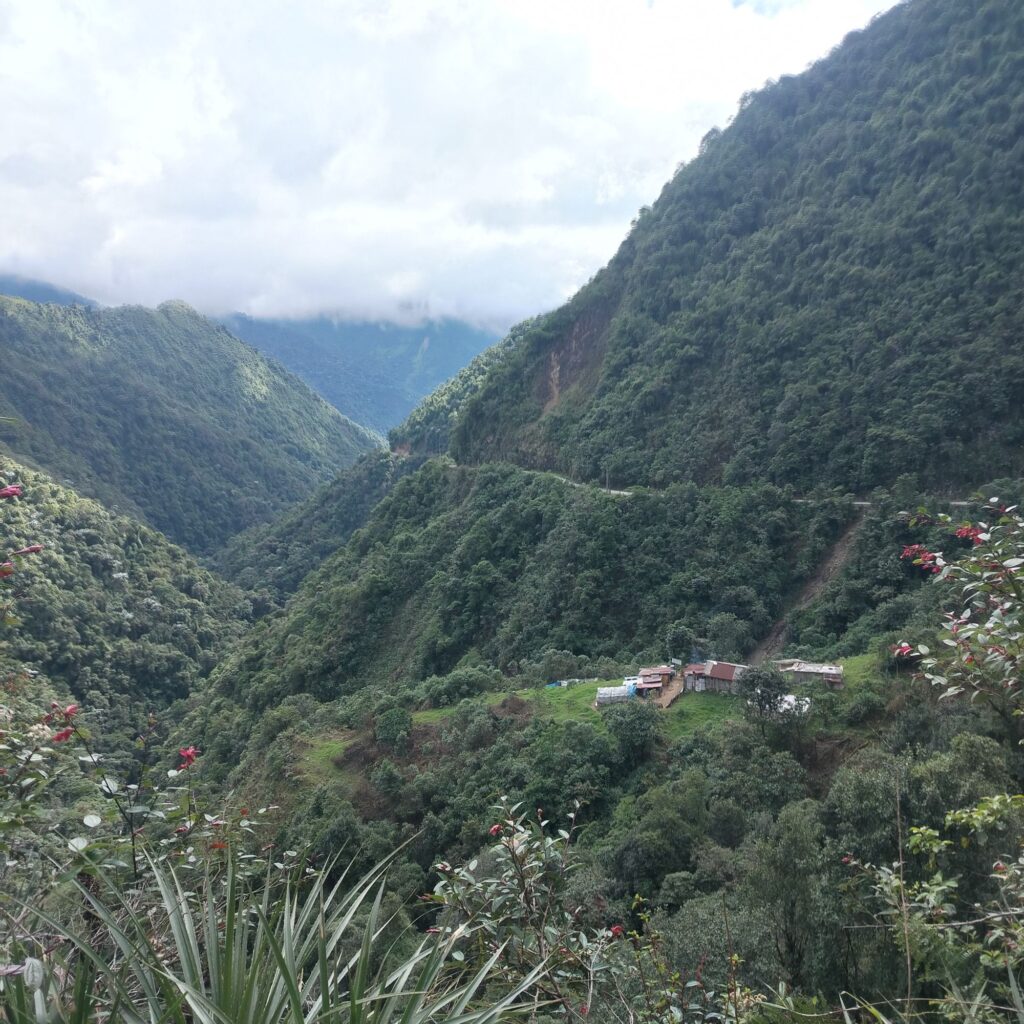
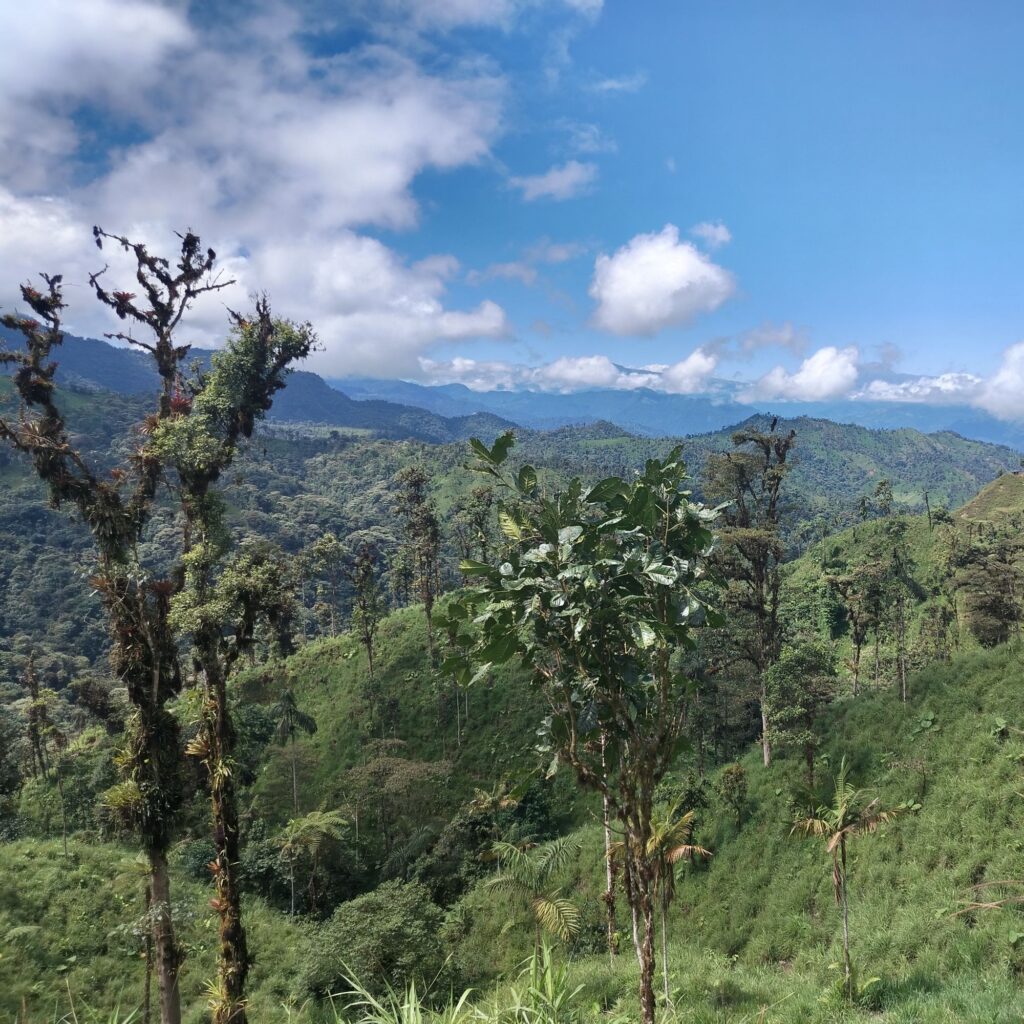
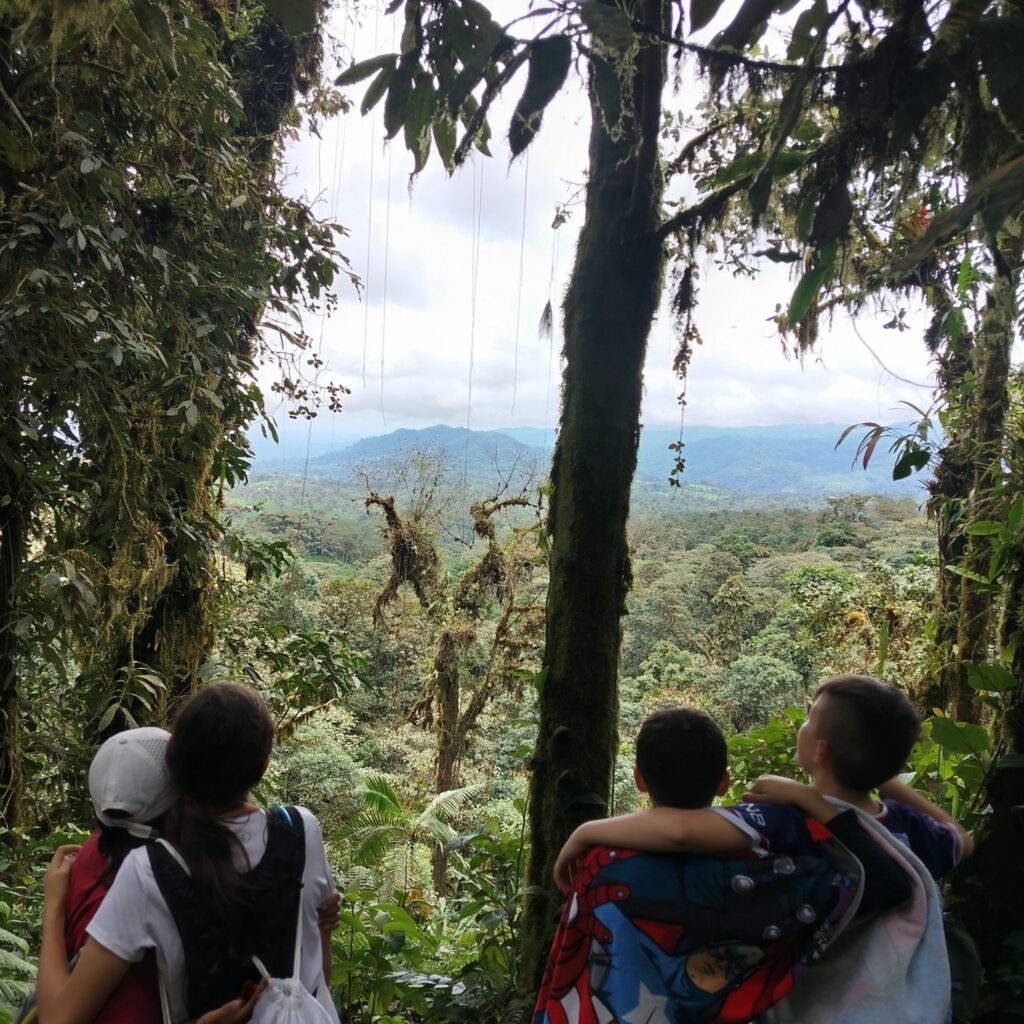
School trip to Mindo.
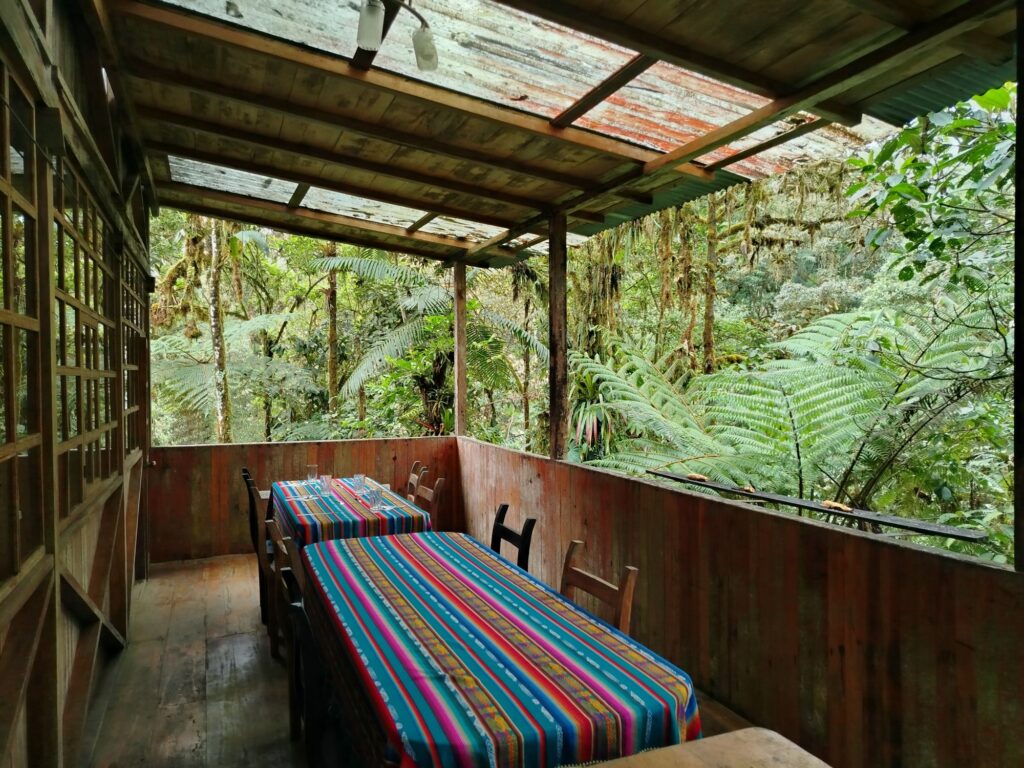
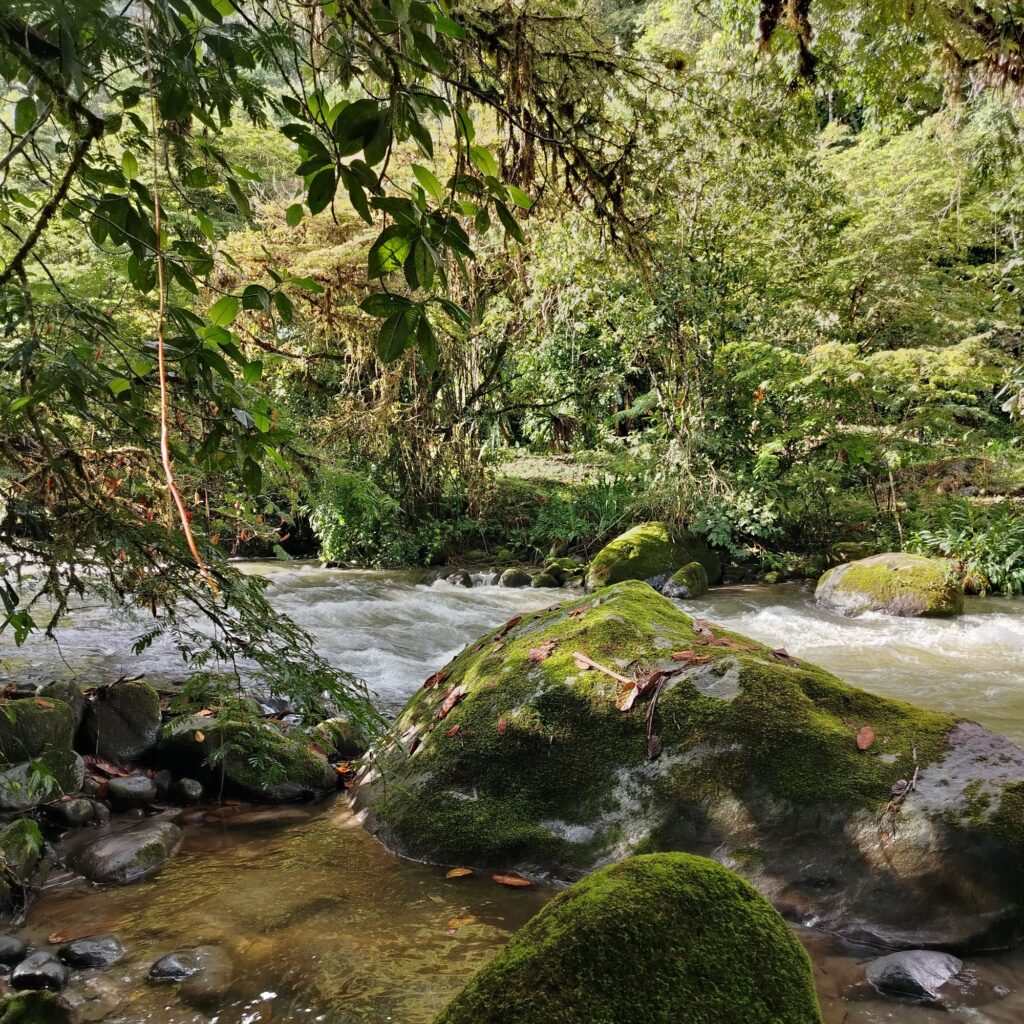
View from my campsite at Mindo Real Lodge.
Mindo had the highest recorded number of bird species on the planet for a couple of years. More recently it has lost its title, but remains undoubtedly one of the most biodiverse places in the world. It’s a quick two hour bus ride from Quito. I’ve been about 6 times by this point, and there’s always something new to see every time.
I will never get tired of watching hummingbirds. You will often see them zipping around flowers all over the country, even in urbanised areas like Quito. They seem to serve as a nice reminder to stop and take notice of the beauty around you in the middle of a hectic day. People put out feeders filled with a water-sugar mixture (white sugar, not brown, brown sugar apparently kills them…) in leaner months. Fun fact: Hummingbirds are actually insectivorous. They only drink nectar from flowers to get enough glucose to maintain their highly energetic lifestyles. Every now and then you can find a hummingbird lying prostrate on the ground, exhausted. Just give it a little dish of sugary water and it’ll be up and about in a few minutes.
The Amazon.
I grew up watching people like David Attenborough and Ray Mears exploring the Amazon rainforest. Living just a short 5 hour bus ride from that vastness of biodiversity is incredible.
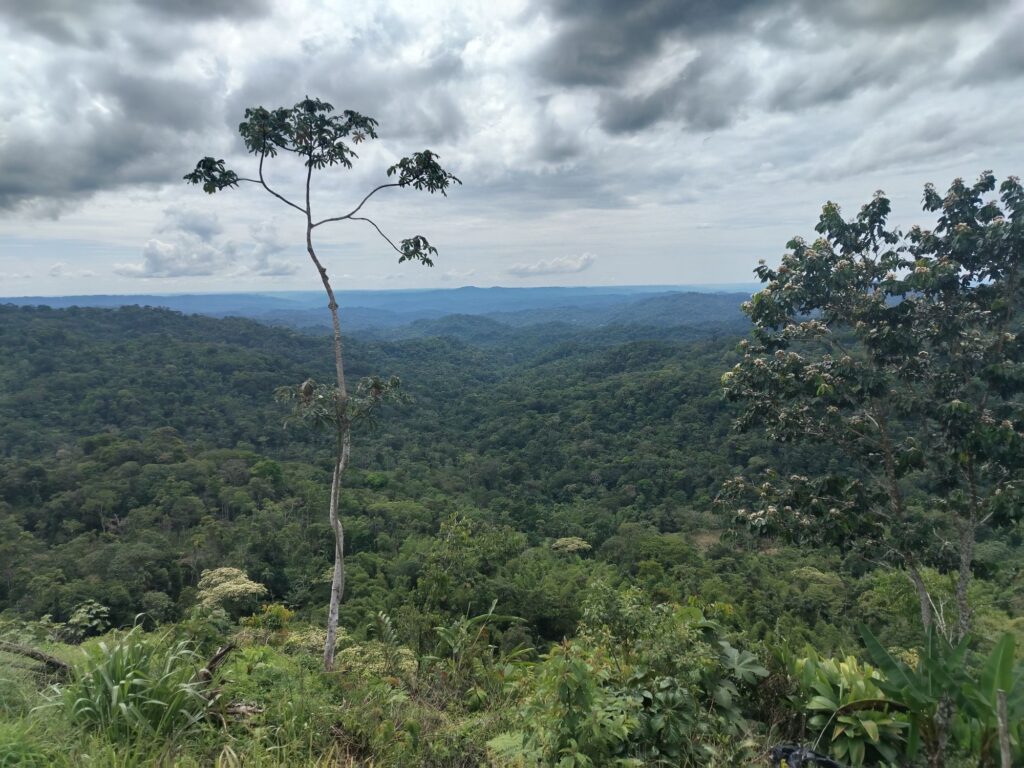
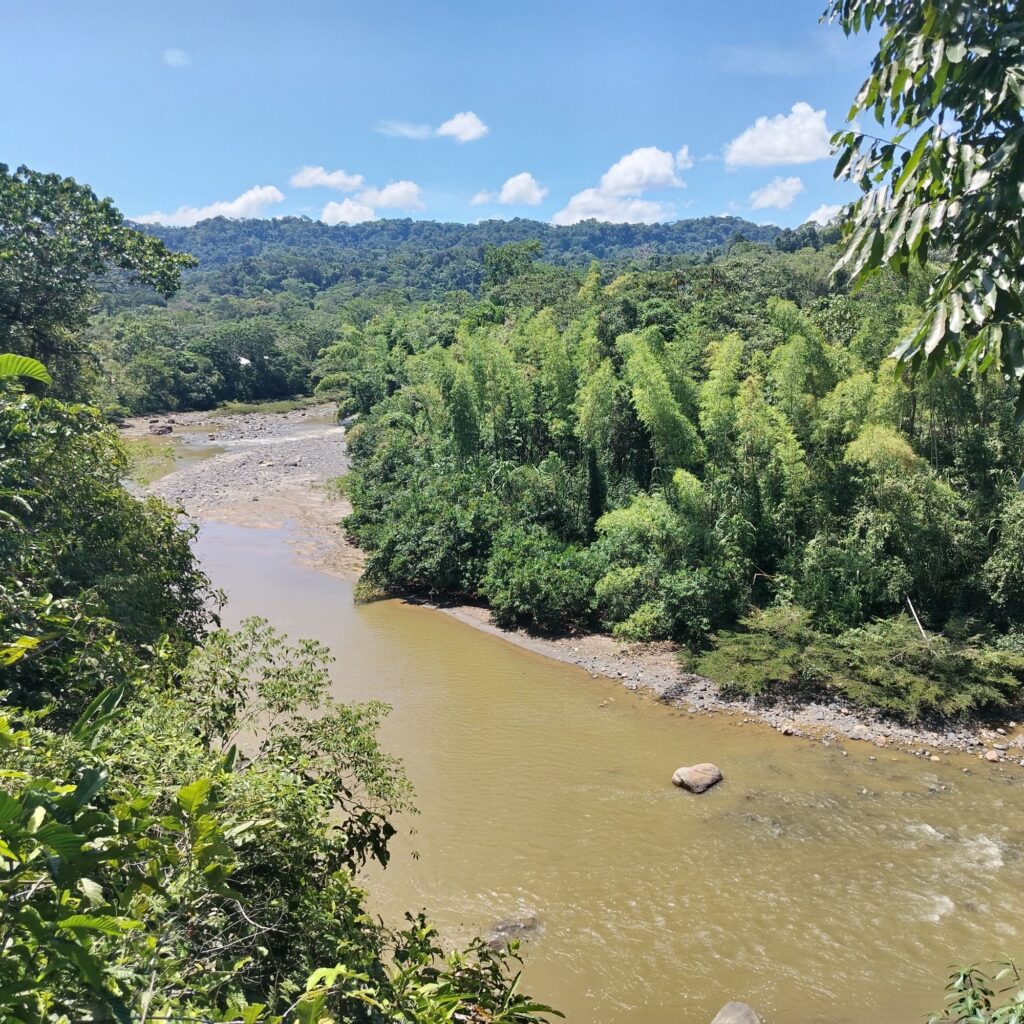
Due to the lack of road infrastructure, and a dependence upon rivers for transport, many native communities have been somewhat cut off from the recent leap forward in development that took place in Ecuador in the last decade. Communities in tourist-trodden parts such as Misahualli are accustomed to making a few bucks off visitors, but if you head off the beaten track the locals can be much more wary of outsiders.
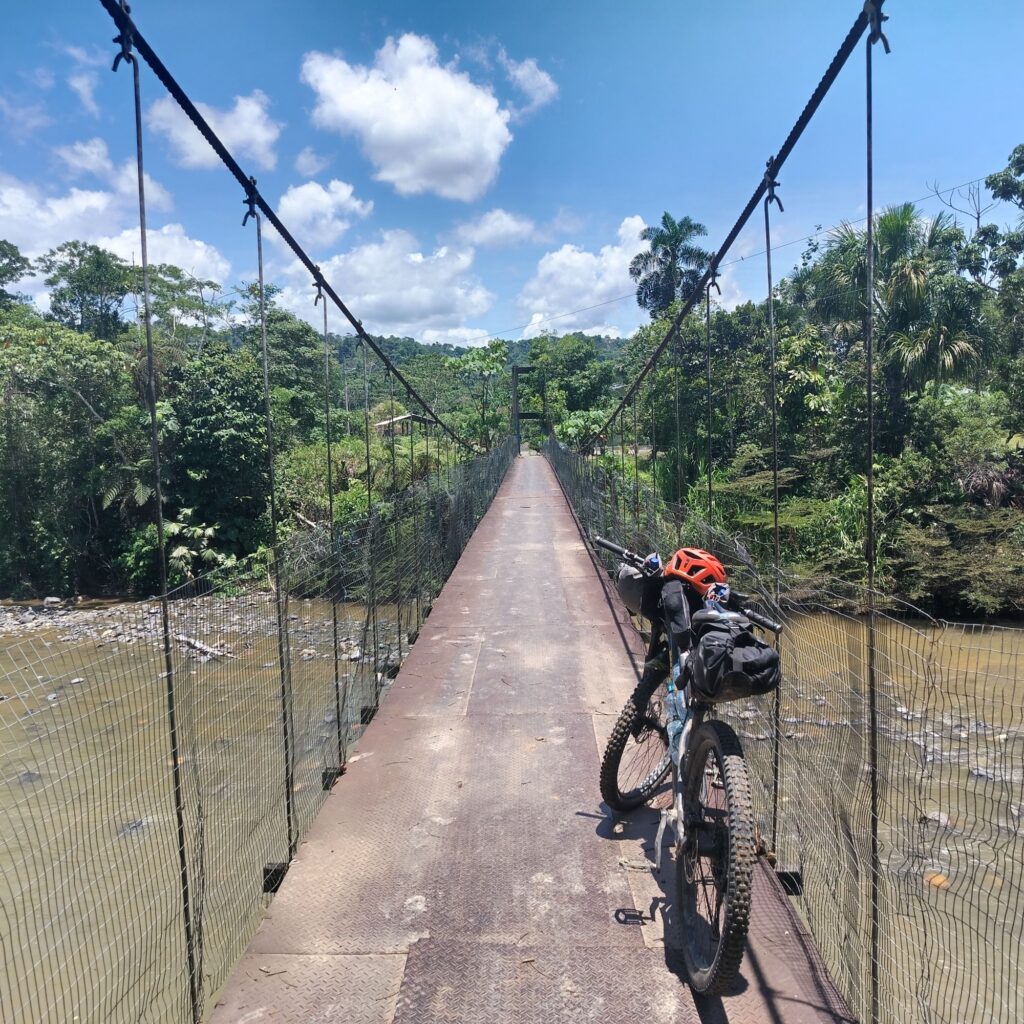
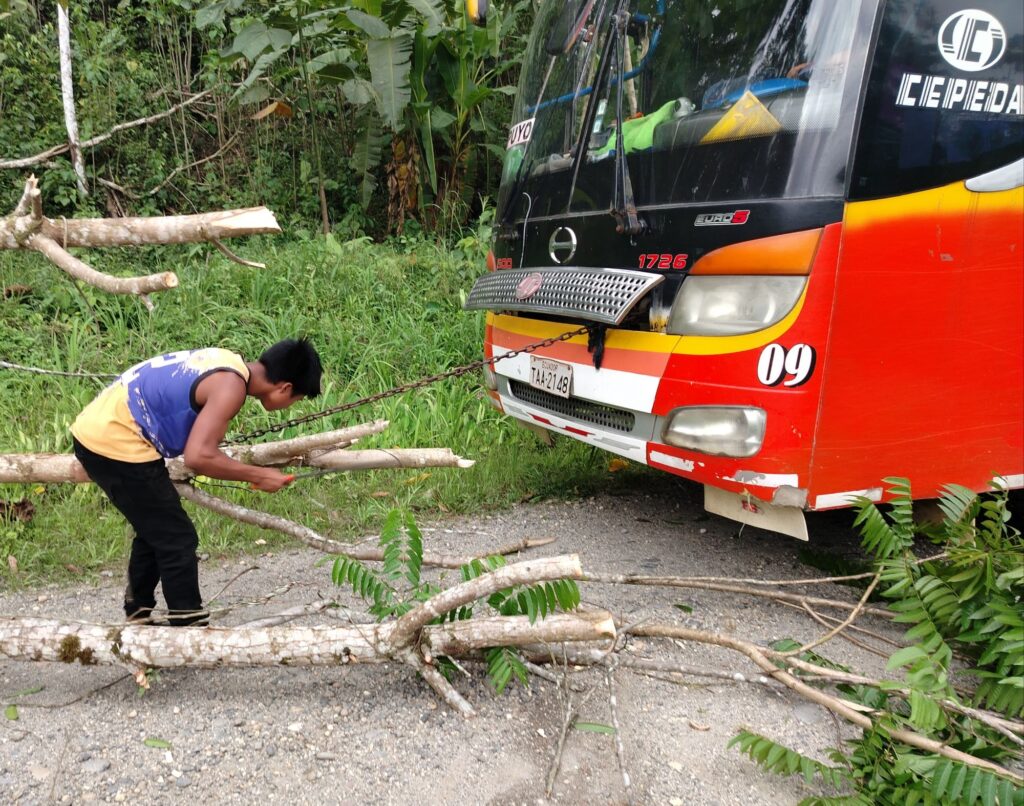
Clearing a downed tree from the road with my very blunt machete.
There are several remote lodges that tour groups can take you out to. Pink river dolphins are a thing apparently. Usually trips are at least 3 days long and cost around $600.
The beach.
Whenever there is a feriado (vacation/ long weekend) there is a mass exodus of humanity from Quito to the coast.
And they are absolutely in their right minds for doing so.
Ecuador has a stunning pacific coastline, from immaculate nature reserves, such as Playa de Los Frailes, mangrove forests at Mompiche, surfing hotspots like Olón, party towns like Montañita and bustling vacation resorts like Salinas. Come down to Puerto Lopez in Manabi you can see Humpback whales and their calves from June until October.
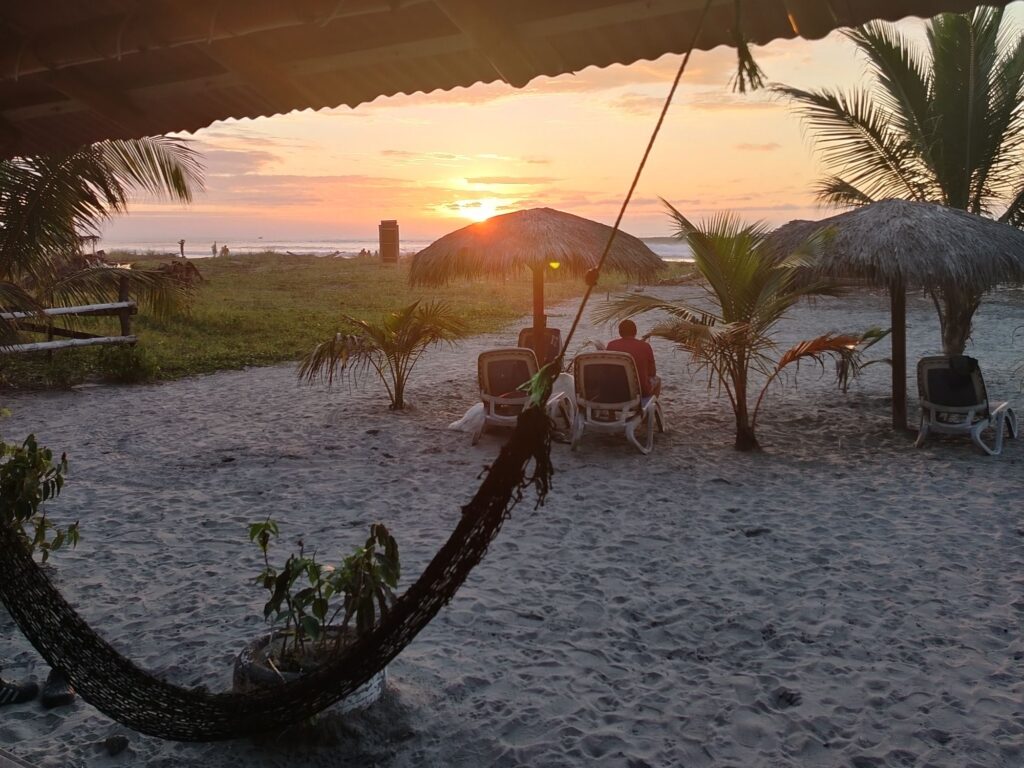
Mompiche.
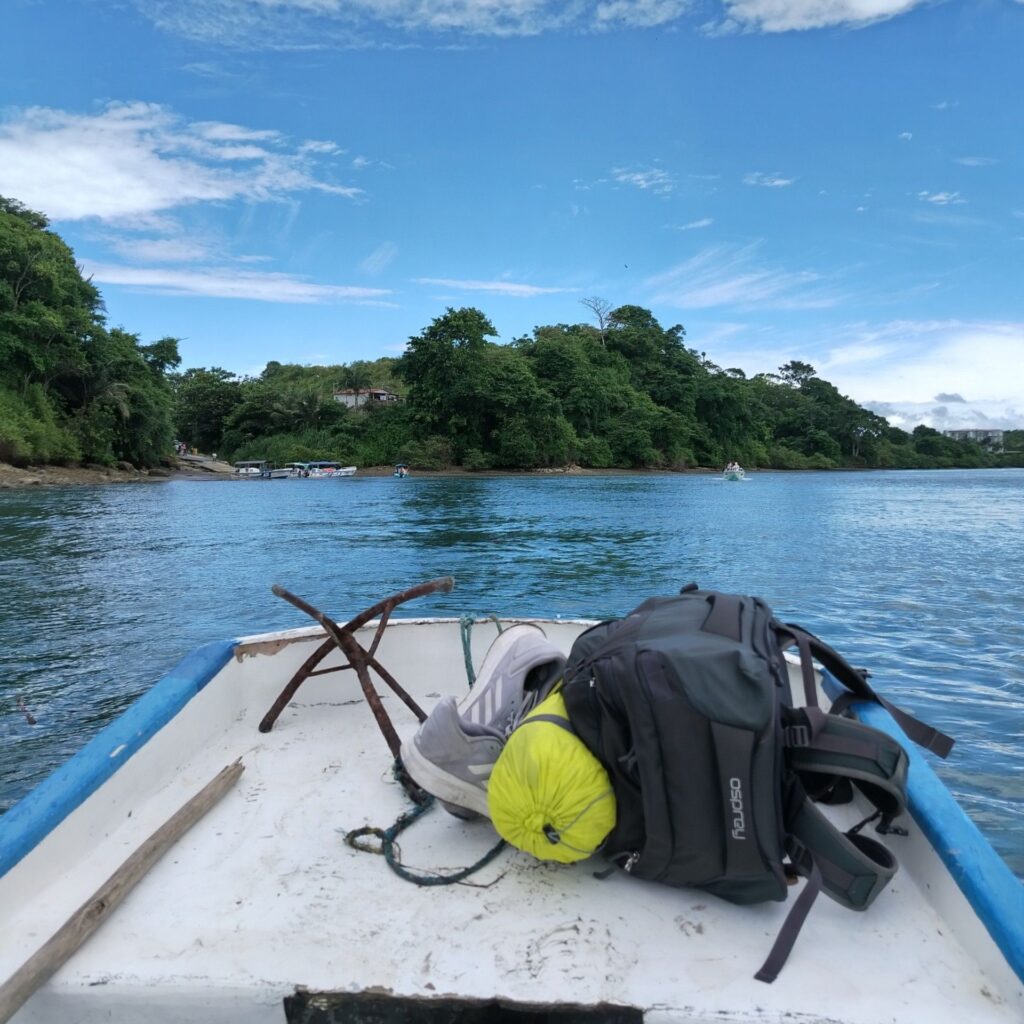
Mompiche.
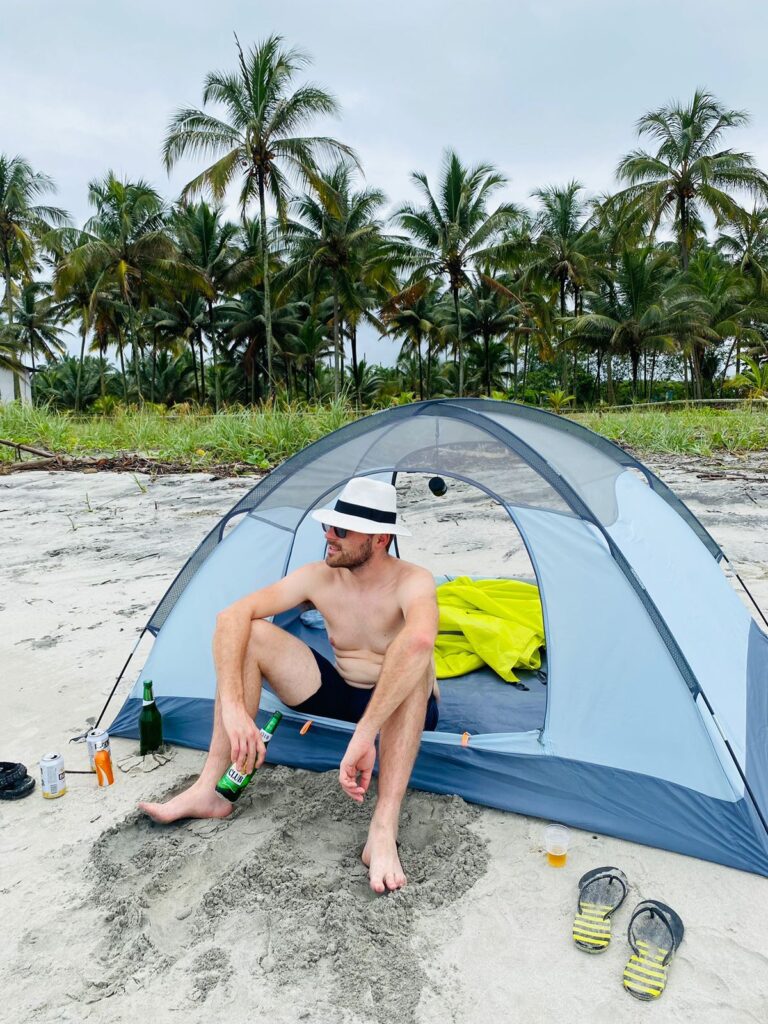
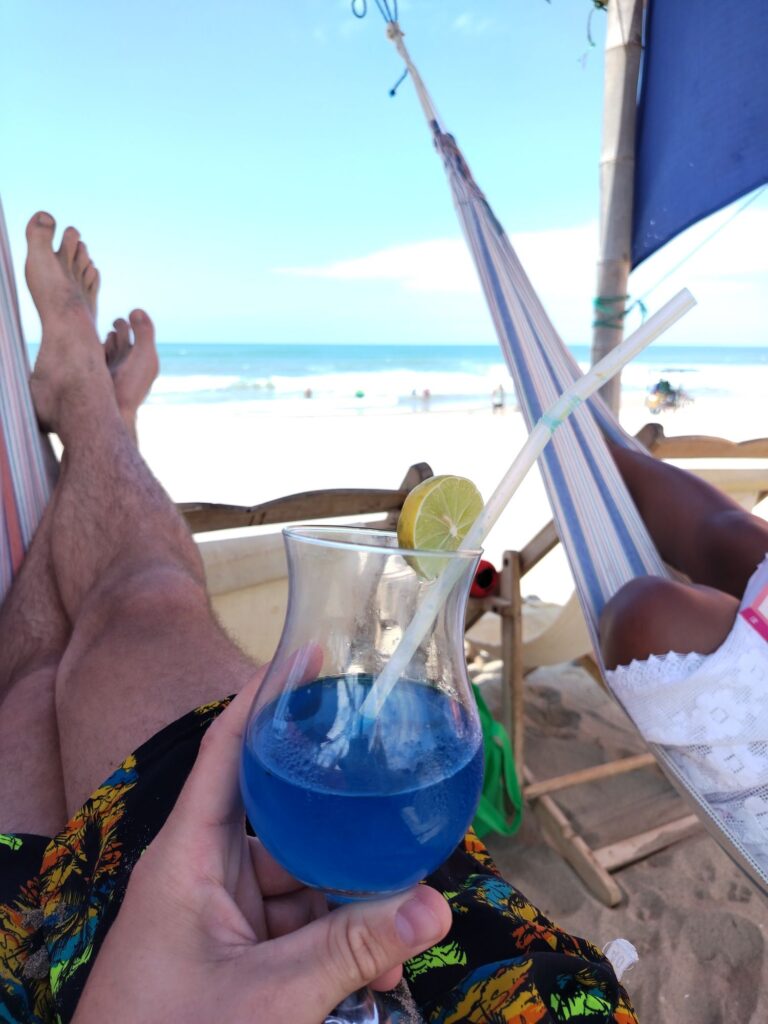
Canoa.
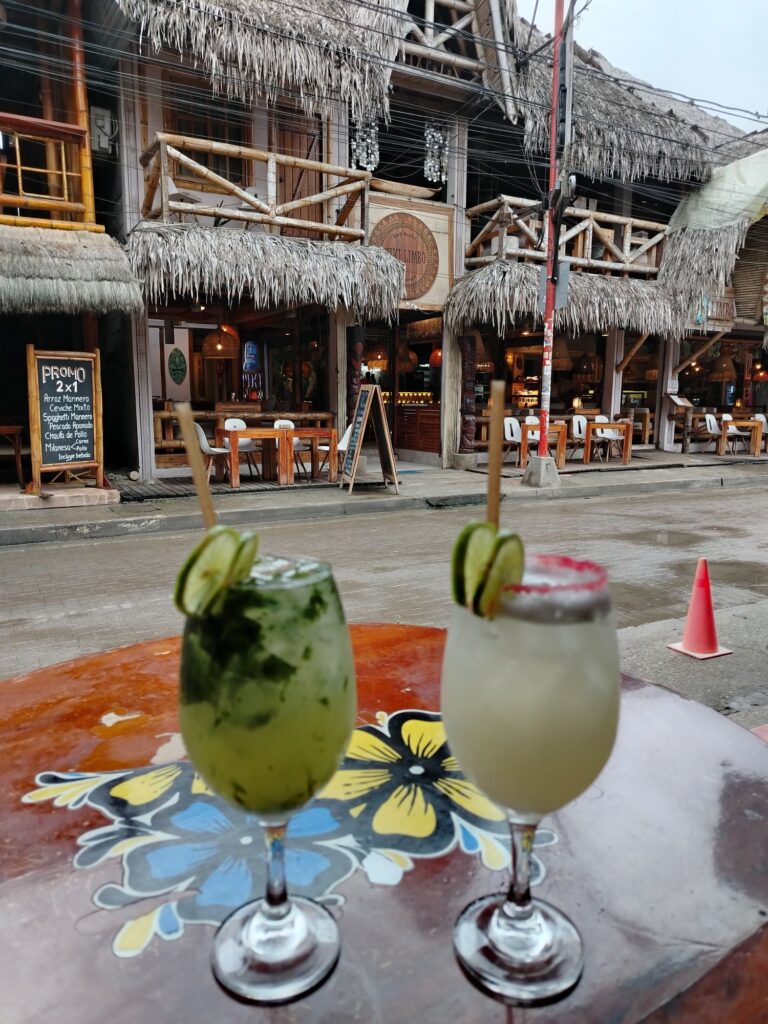
Montañita.
If you want to quickly spark up a conversation with an Ecuadorian, ask them what their favourite beach is.
History and culture
The largest colonial old town in South America? Quito, Ecuador. The largest artisanal market in South America? Otavalo, Ecuador.
Ecuador has 14 distinct indigenous nationalities. Their culture is very much alive and well. In the Amazon you can learn about all the properties of medicinal plants from the tribespeople, try an amazonian caffeinated drink called guayusa, make your own chocolate, and dance with spears in a thatched longhouse. In the sierras you can meet the Quichua (Kichwa) with their distinctive felt hats, eat some guinea pig, drink a cup of coca tea, and get yourself an alpaca wool poncho. Indigenous folk music and dance is very popular; several folklore festivals crop up all over the country.
Unfortunately, these groups continue to be very poorly taken care of by the government. For example, during the Correa administration, great progress was made in expanding energy supply and infrastructure across the country. This march of progress rather conspicuously left indigenous communities behind.
Whenever I visit places like Otavalo or Ibarra, I always try to buy some kind of artisanal product to try and help the locals out. And the stuff they sell is really decent! Alpaca wool is an excellent fabric, it’s soft, stays warm when wet, and is very affordable here. You can grab a really nice wool hoodie for $20, ponchos are even cheaper, about $16.
The iconic Panama Hat? They come from Ecuador! The sombrero de paja toquilla was traded up and down Latin America, and it became available to workers digging the Panama canal, hence the popular adoption of the name. You can pick up a high quality model from the artisanal markets here for just $35 (imports can easily cost a couple of hundred in the west).
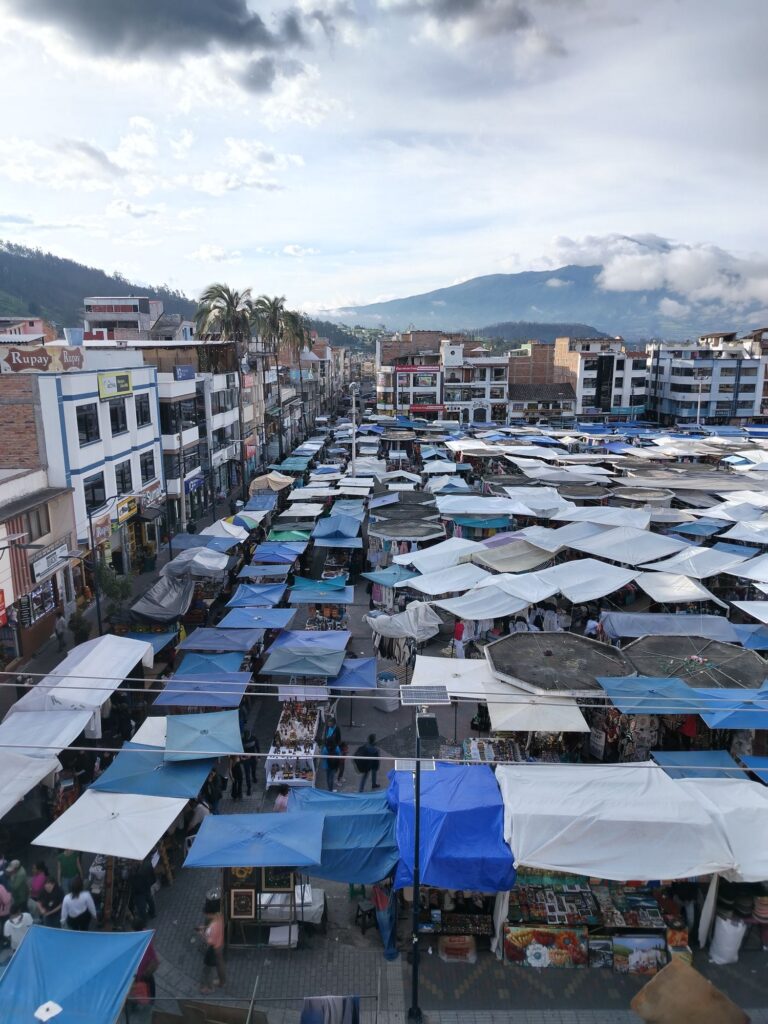
The largest artisanal market in South America, Plaza de Ponchos, Otavalo.
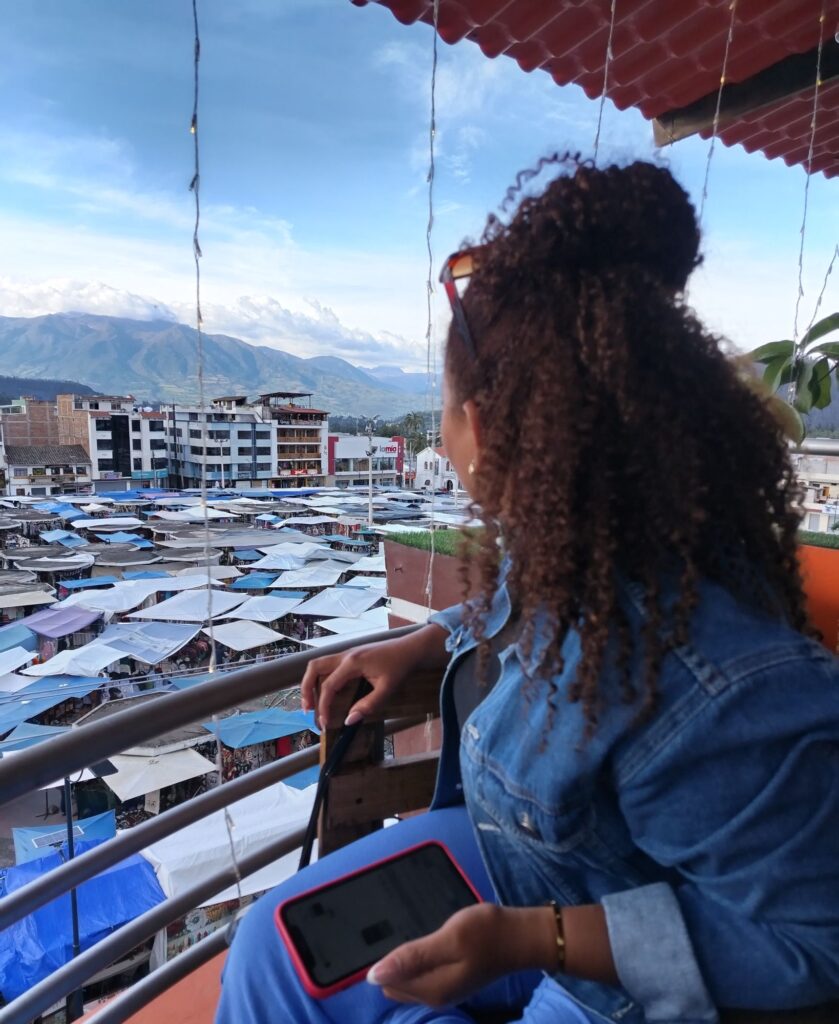
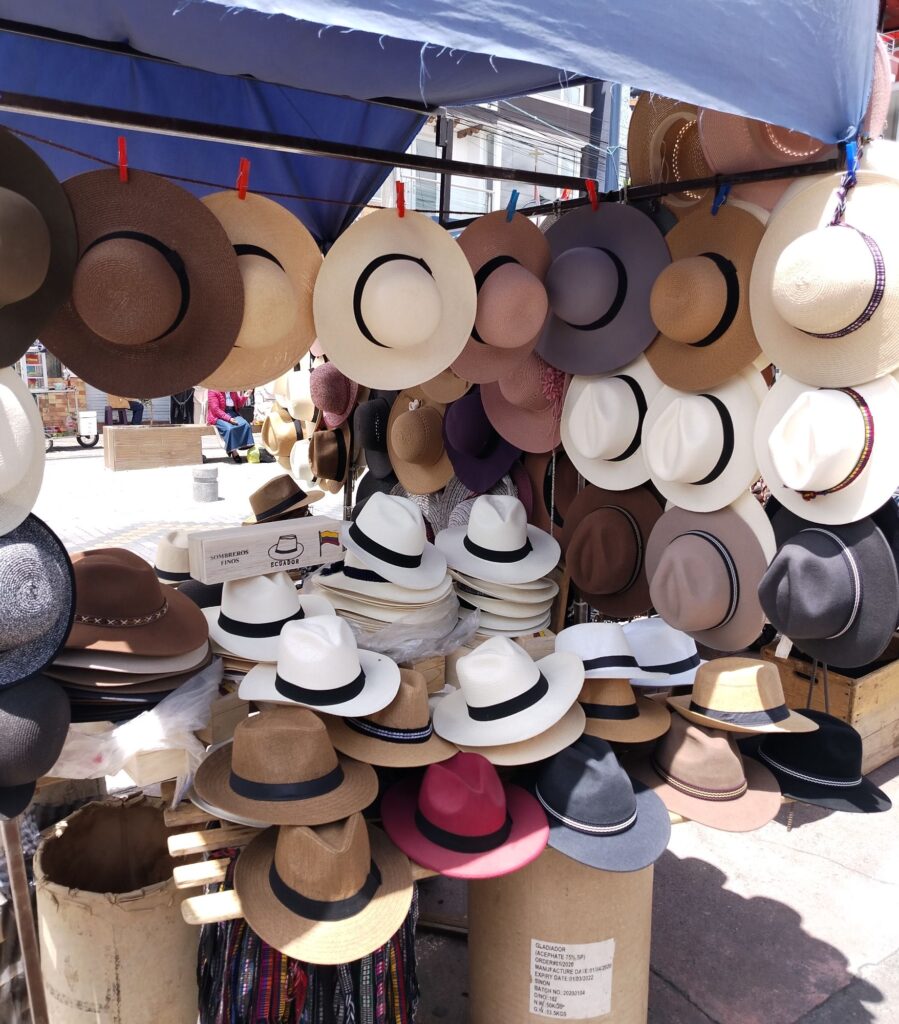
The historic centre of Quito is really worth the visit. Lots of colonial houses, six churches, several museums, and the presidential palace. Just make sure that you are switched on while walking around, since it’s actually one of the dodgier parts of the city, especially at night.
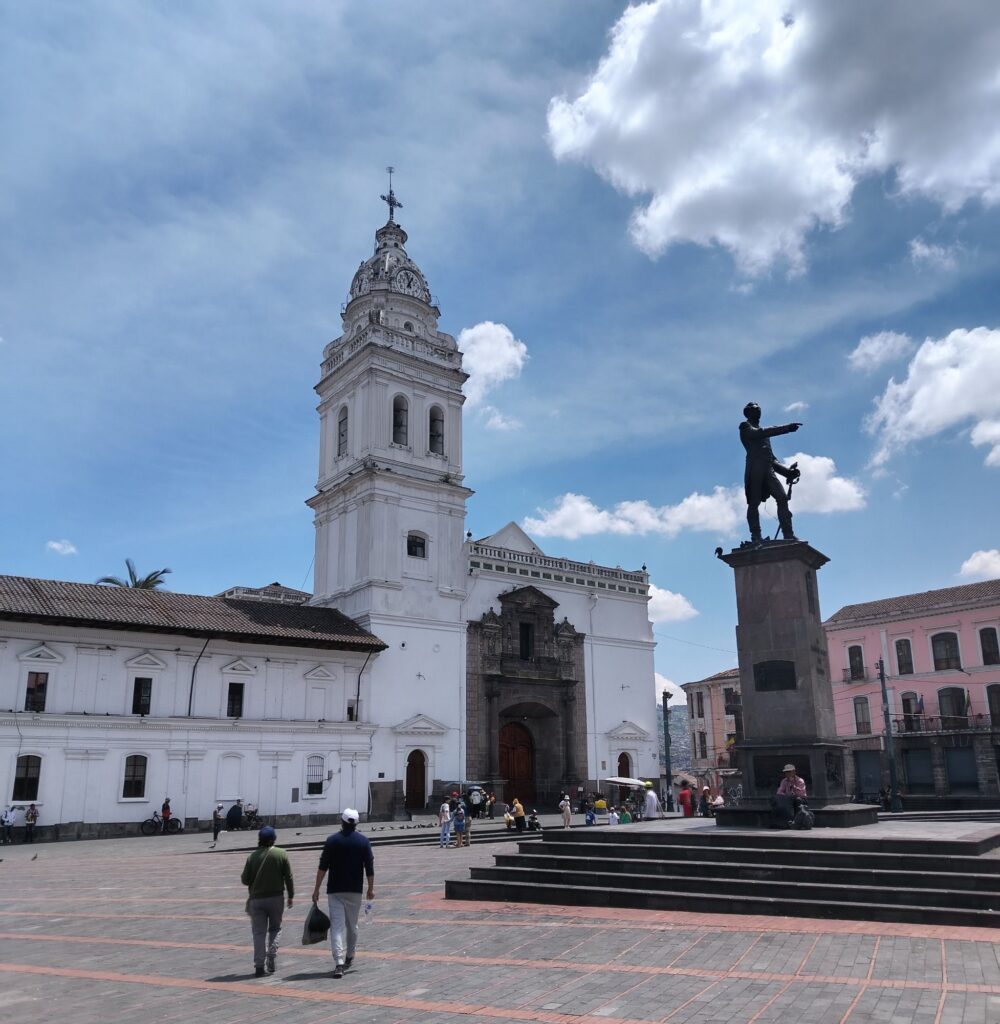
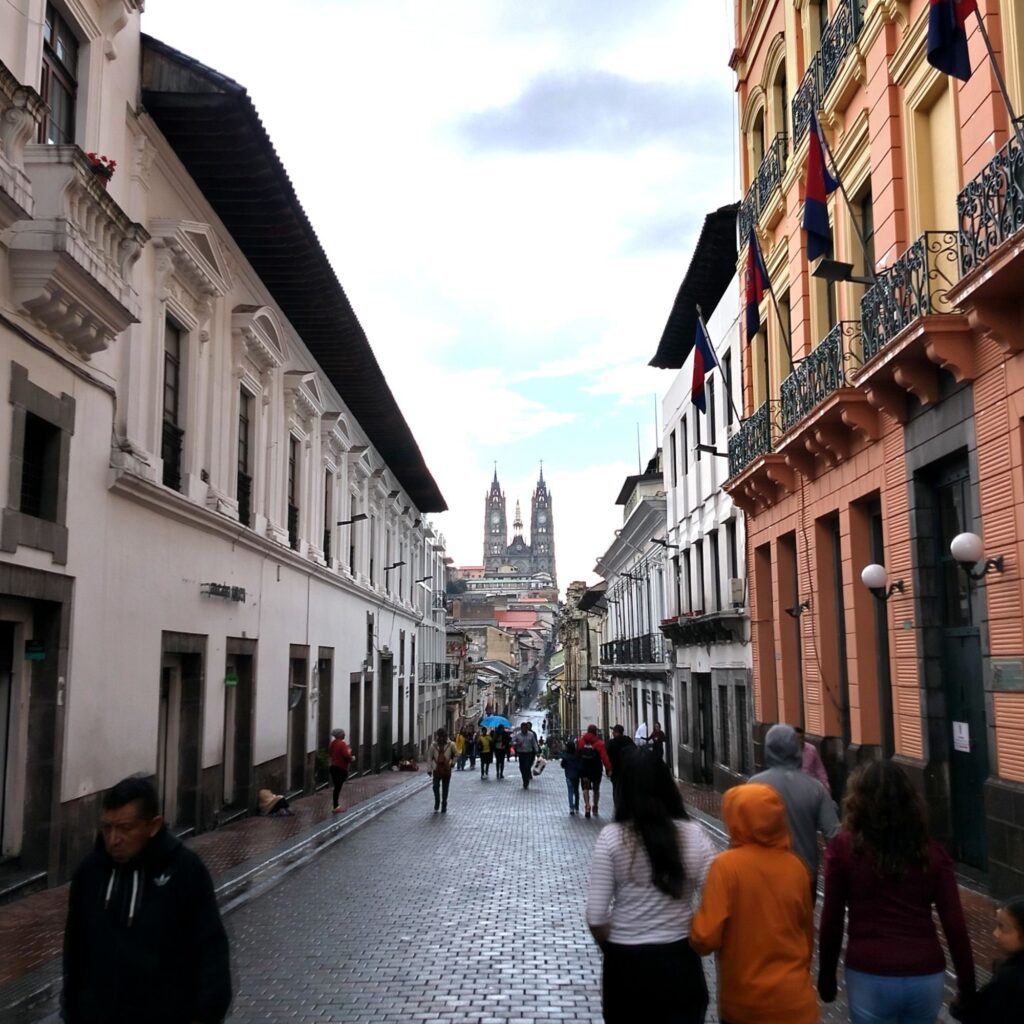
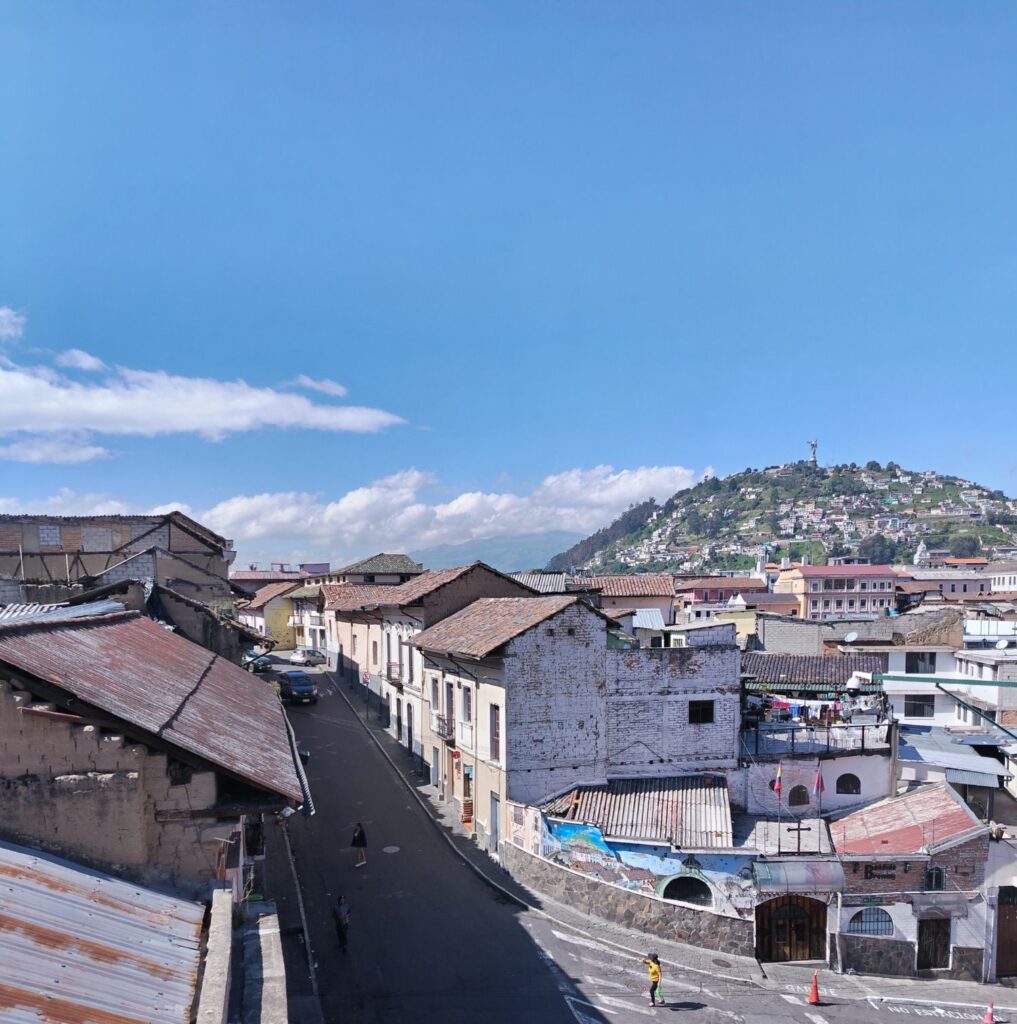
If you want to soak up the history and culture in a more carefree environment, I cannot recommend Cuenca enough. It is a really magical place, with plenty to see and do, and virtually no insecurity. Historic buildings, art galleries, museums, a zoo, excellent restaurants, a lovely long riverbank walk and decent sized parks. It’s a very walkable or bikeable city in general. I reckon Cuenca must be at the top of my list of places where I would consider settling down long term in this country. Whenever I visit I just take a deep breath and feel my cortisol levels fall.
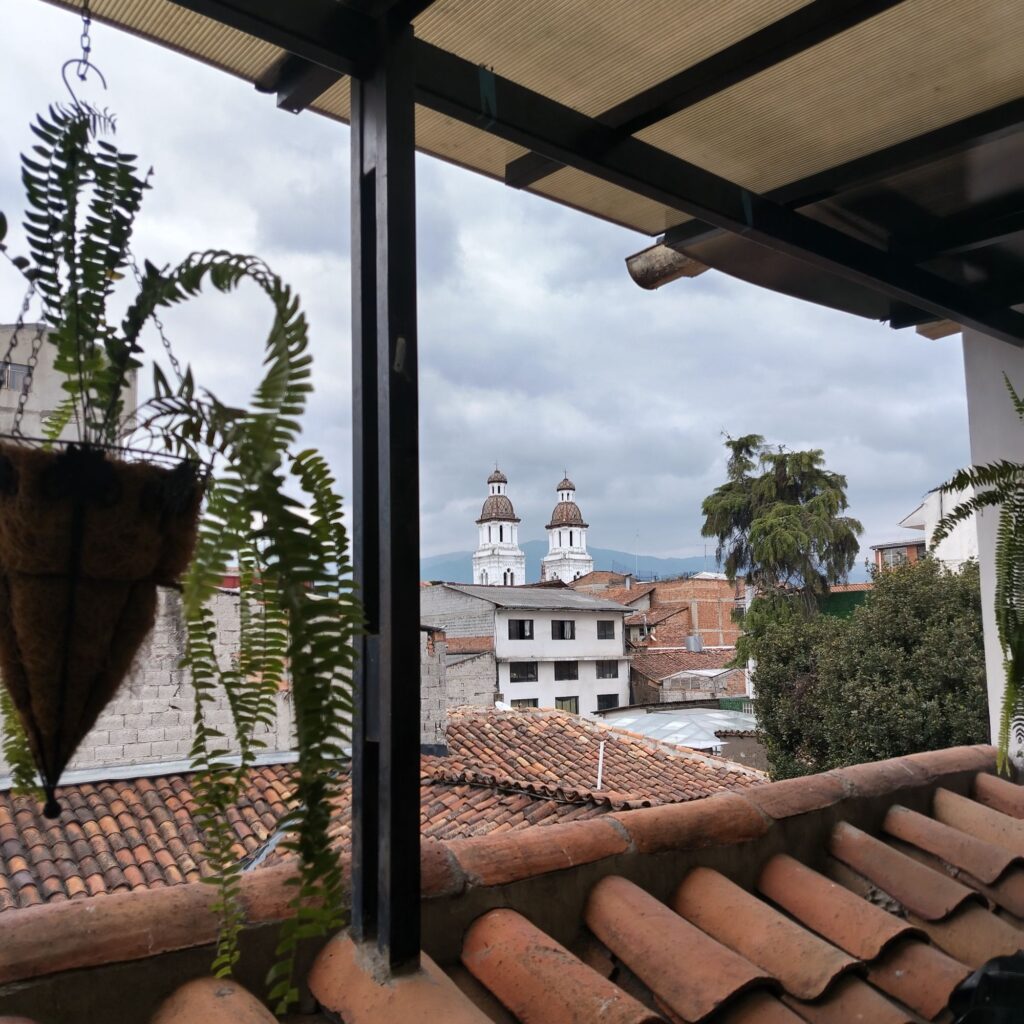
Cuenca.
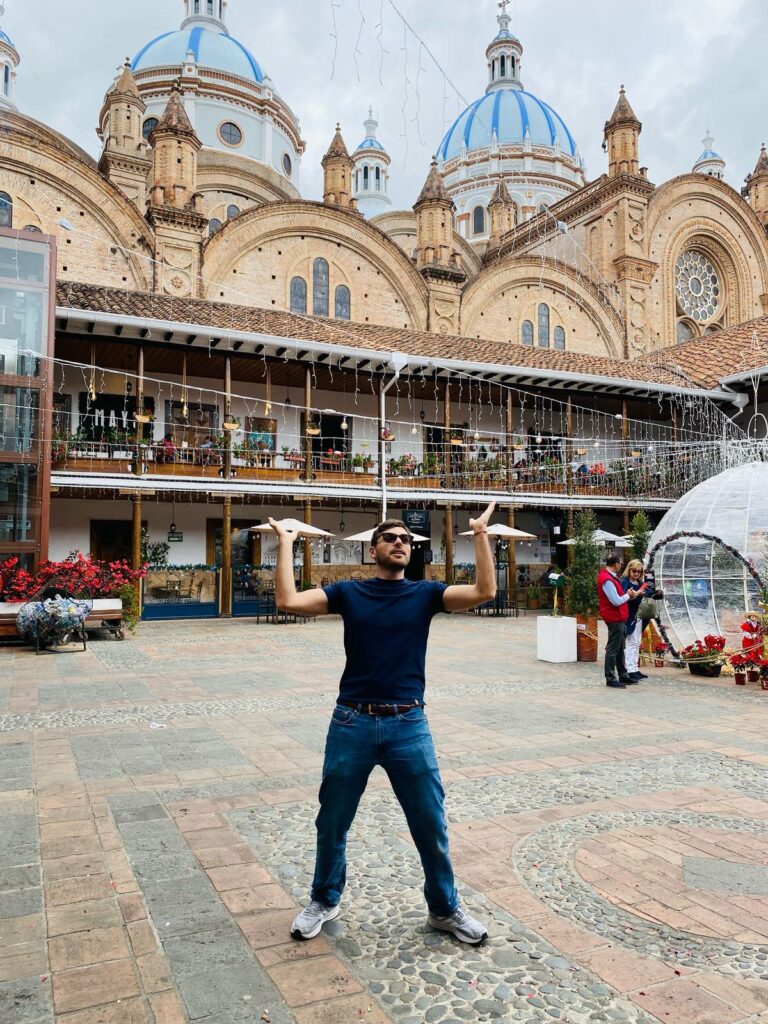
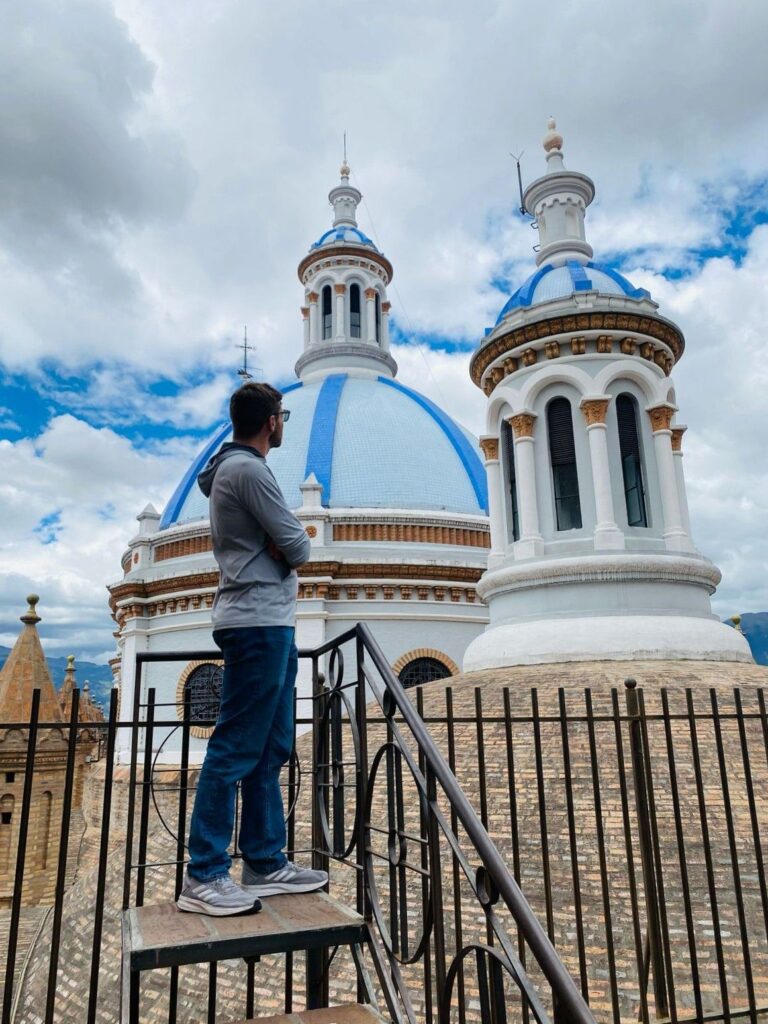
The people
I feel like this applies to a lot of Latin America, but the people are incredibly warm and generous here. Ecuadorians just have better social skills. I’ve made so many friends here because people are actively sharing their lives with other people. You can make plans and not get hit with a load of excuses.
Back in the UK people will say things like ‘oh you MUST come and visit sometime’ (translation: please don’t ever come and visit), but they really do mean it here.
Within days of arriving in the country I got invited to come along on a roadtrip with the church group of the social worker at my new job. In no time I found myself standing up in front of a whole busload of the congregation, giving a sermon in broken Spanish, before singing ‘he’s got the whole world in his hands’ into the microphone. As a northern european you really have to rewire your brain a bit; we often immediately jump to responding no to things where a latino would say yes.
As a social introvert it can be a bit intense at times, ‘wow everybody sure loves to dance here’ can easily turn into ‘wait, we are dancing AGAIN?!’ In the professional sphere you are expected to turn up to social events, dance, and look happy. It is frowned upon if you don’t. Also, because it is a social norm to be extremely friendly, it can be difficult to catch a glimpse of the real person behind that which is being put on show. People certainly don’t have fewer flaws here than anywhere else in the world.
I reckon that I’ve made about three or four times as many friends in just a year and a half here in Ecuador than I made in the previous 5 years in the United Kingdom.
I’m incredibly grateful for all of the great times that I’ve shared with people in this country. Thank you all so much. It’s going to be very difficult to leave…
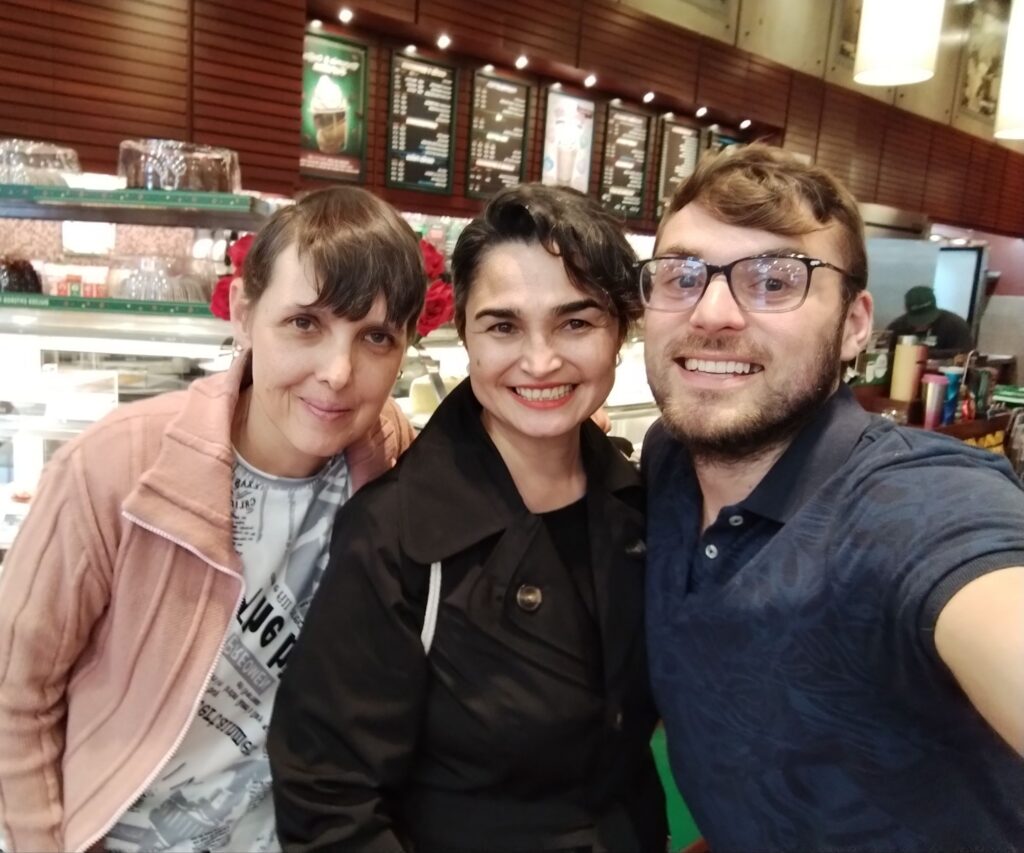
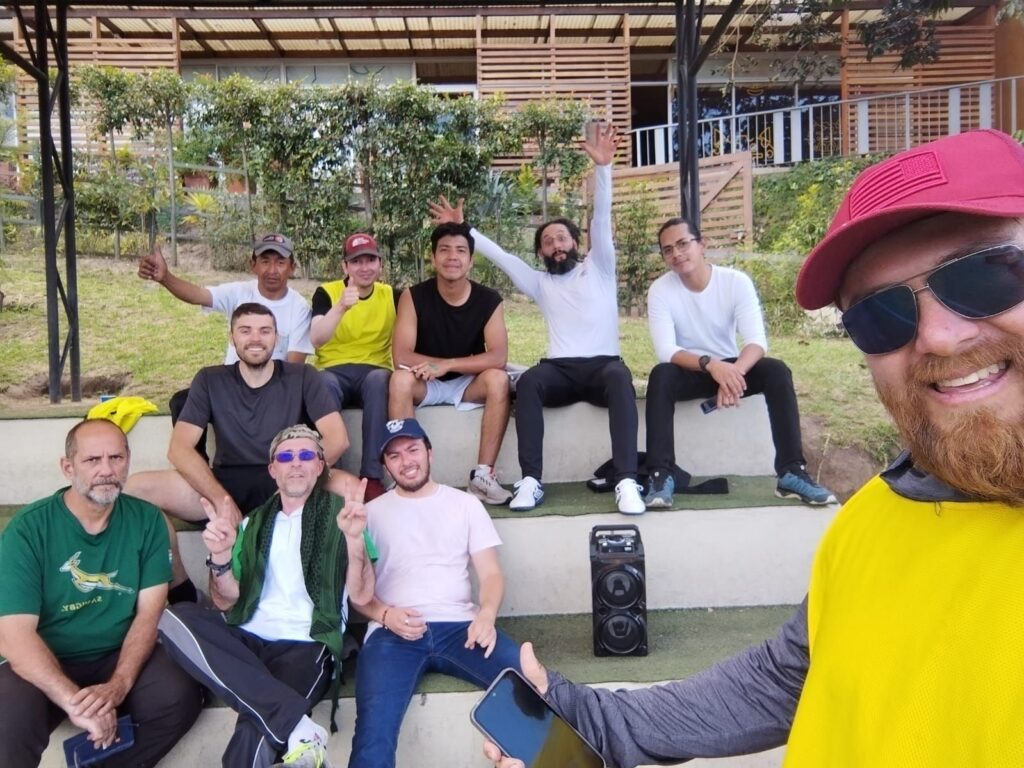
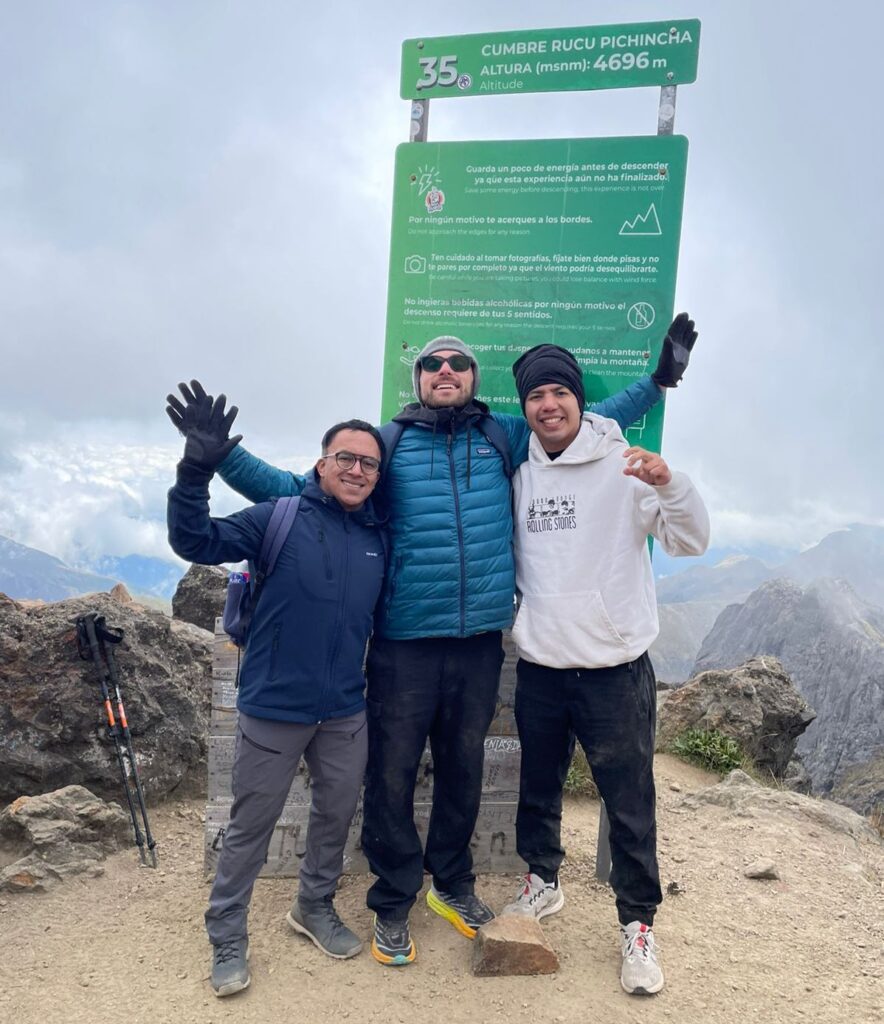

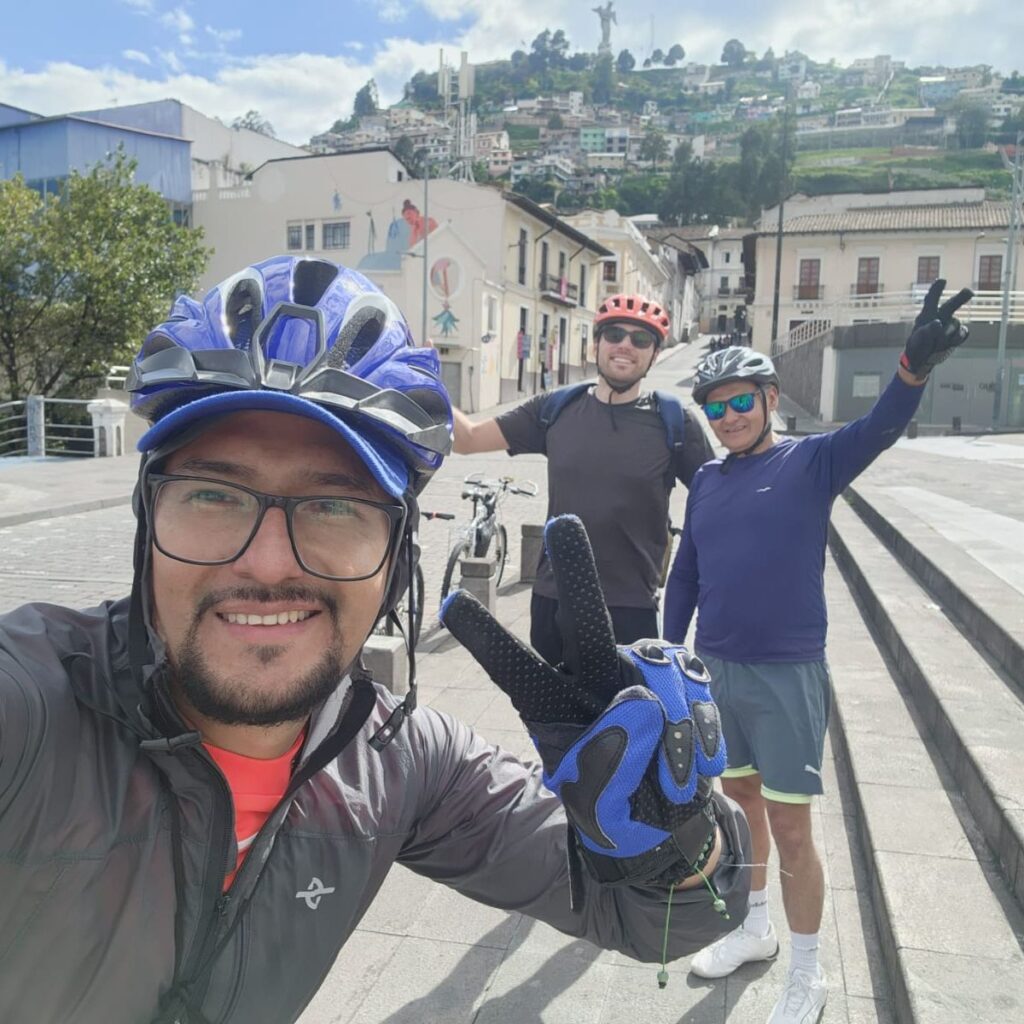
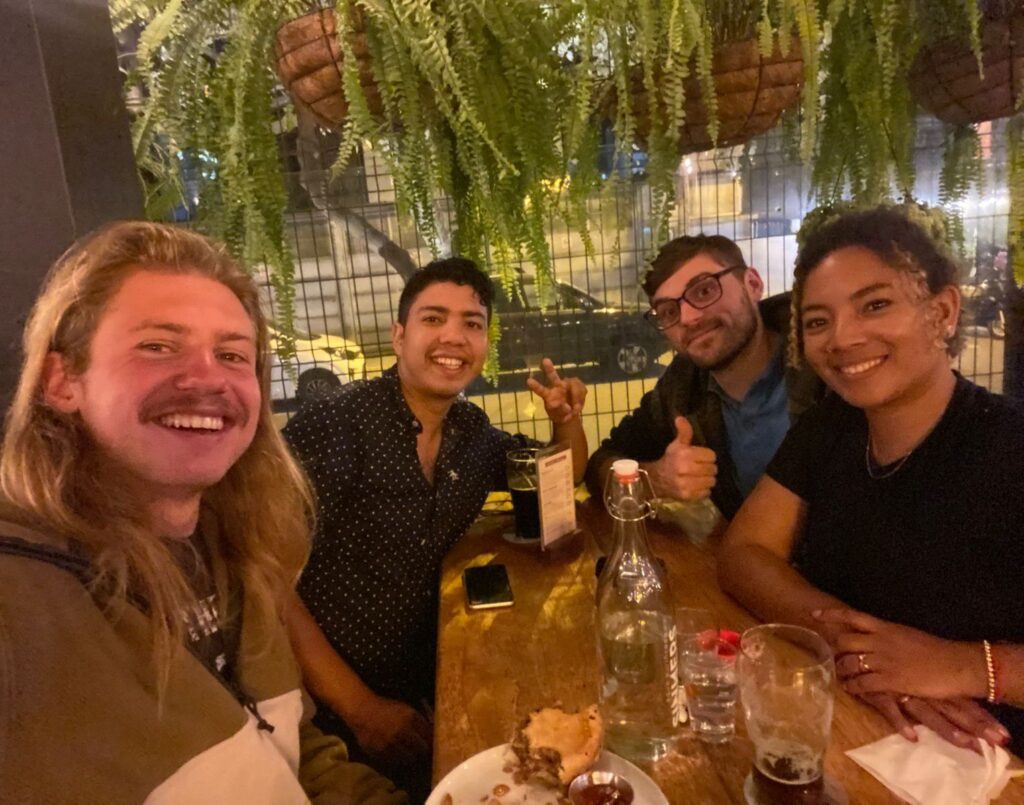
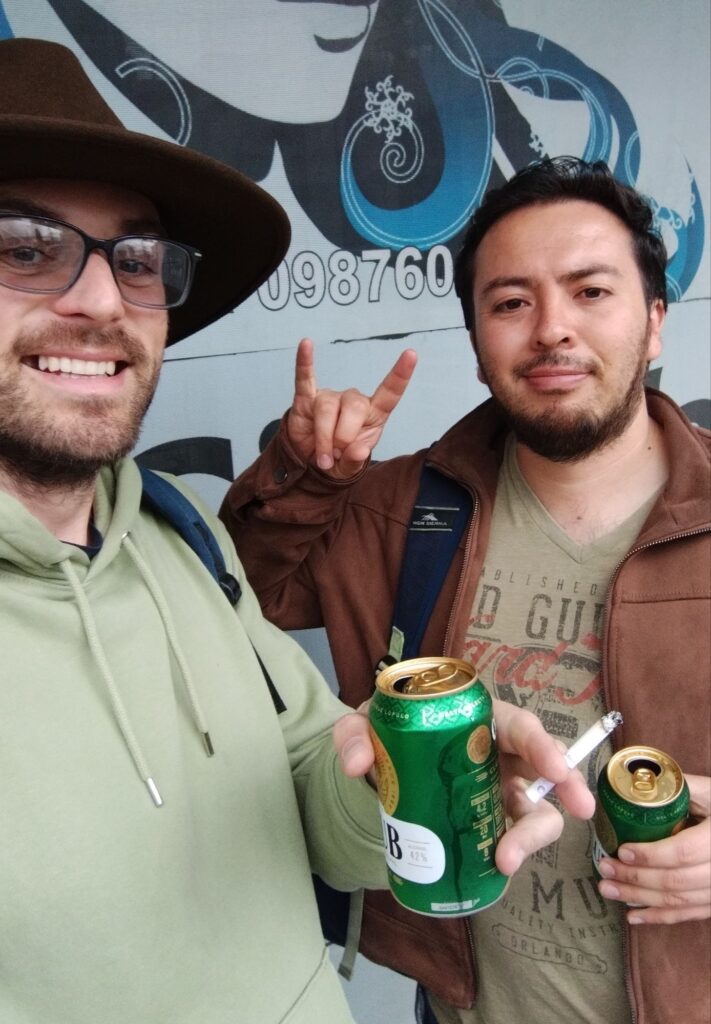
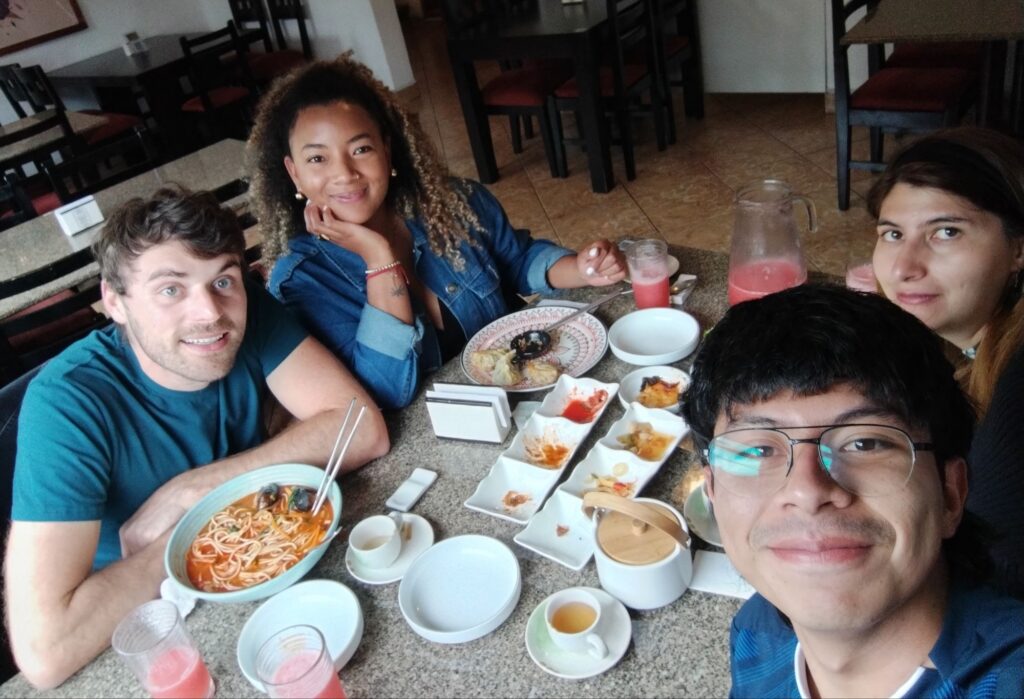
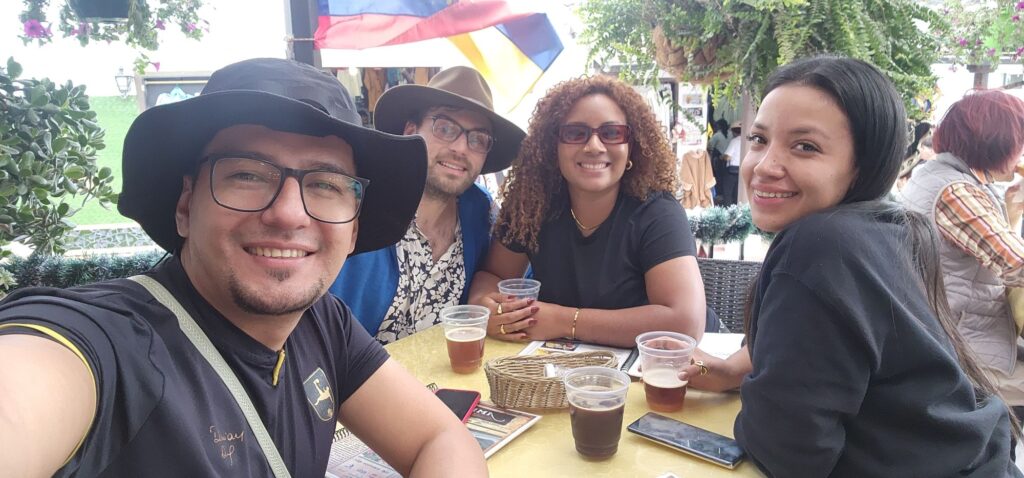
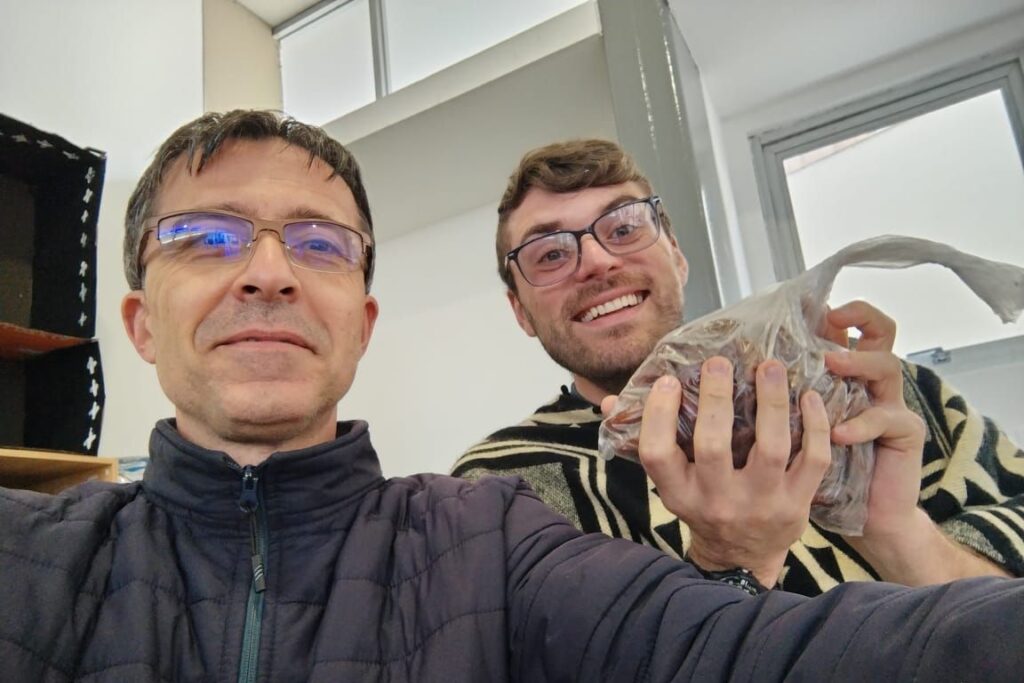

Cheers everyone. This was all that I could find on my phone, so don’t panic if your picture isn’t up there and you thought we were mates!
So there you are, 4 reasons you must come to Ecuador. By all accounts the Galapagos is absolutely worth a visit; I’ve noticed that most travellers tend to head over there, but then spend very little time exploring the mainland, which is a real shame! Hopefully after reading this entry you will consider giving it a chance.
This entry is the counterpart to 4 reasons not to come to Ecuador.
Awesome blog dude !!!!!
Thanks for stopping by! I’m going to try to write up my travels here.
Súper. Gracias por un buen blog. ¡Qué fotos tan lindas y por tu explicación! Tienes razón Ecuador ofrece más cosas que sólo Galápagos. Felicidades.
Gracias un montón mi profe!
YAAAYAYAYAYAYAYA FINALLY!!!
Positivity!
🙂
Thank you for sharing your experiences. It was fun to read and learn more about Ecuador!
Wishing you well on your next adventures and thank you Ecuador for making Chris so welcome.